Comtrend 5374 Multi DSL Wireless Router User Manual UM CT 5374 A2 0
Comtrend Corporation Multi DSL Wireless Router UM CT 5374 A2 0
Comtrend >
Contents
- 1. Users Manual 1 of 3
- 2. User manual 2 of 3
- 3. User manual 3 of 3
Users Manual 1 of 3
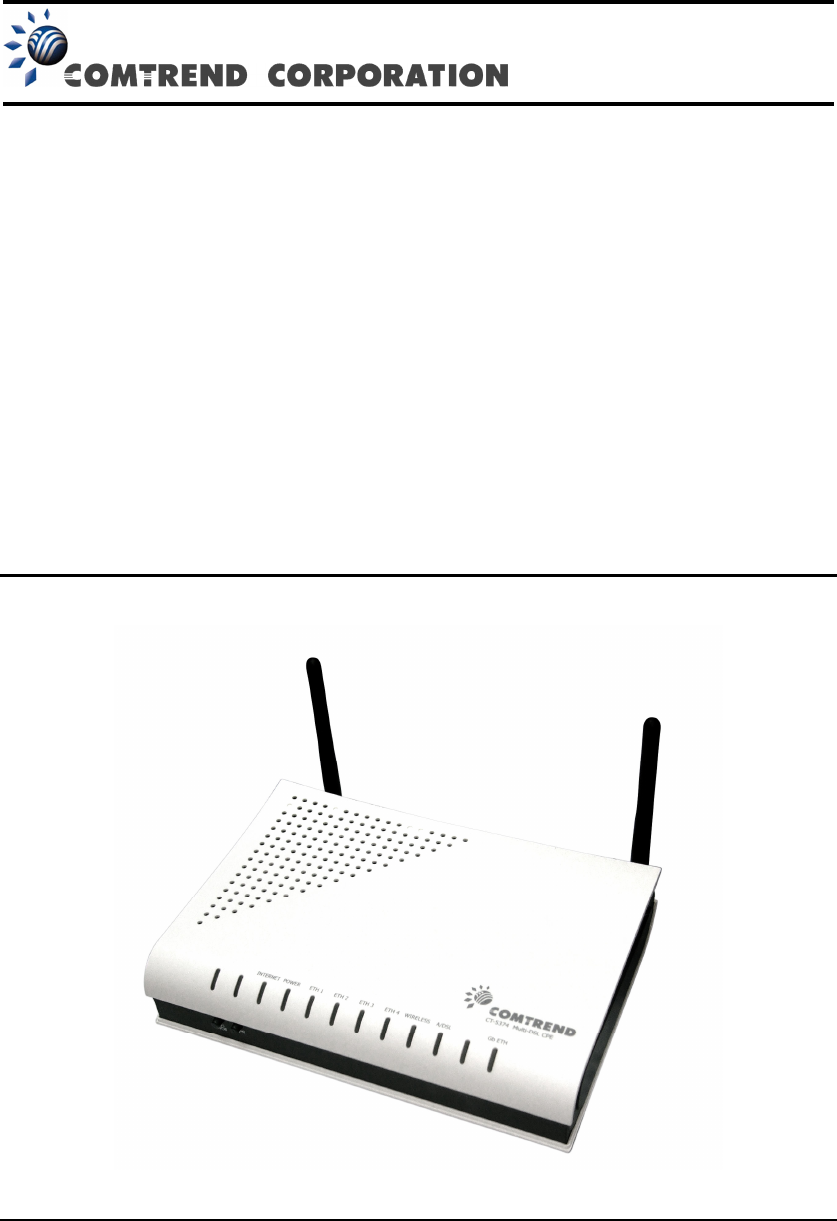
CT-5374
Multi-DSL WLAN Router
User Manual
Version A2.1, April 30, 2010
261099-005

1
Preface
This manual provides information related to the installation and operation of this
device. The individual reading this manual is presumed to have a basic
understanding of telecommunications terminology and concepts.
If you find the product to be inoperable or malfunctioning, please contact technical
support for immediate service by email at INT-support@comtrend.com
For product update, new product release, manual revision, or software upgrades,
please visit our website at http://www.comtrend.com
Important Safety Instructions
With reference to unpacking, installation, use, and maintenance of your electronic
device, the following basic guidelines are recommended:
• Do not use or install this product near water, to avoid fire or shock hazard. For
example, near a bathtub, kitchen sink or laundry tub, or near a swimming pool.
Also, do not expose the equipment to rain or damp areas (e.g. a wet basement).
• Do not connect the power supply cord on elevated surfaces. Allow it to lie freely.
There should be no obstructions in its path and no heavy items should be placed
on the cord. In addition, do not walk on, step on, or mistreat the cord.
• Use only the power cord and adapter that are shipped with this device.
• To safeguard the equipment against overheating, make sure that all openings in
the unit that offer exposure to air are not blocked.
• Avoid using a telephone (other than a cordless type) during an electrical storm.
There may be a remote risk of electric shock from lightening. Also, do not use
the telephone to report a gas leak in the vicinity of the leak.
• Never install telephone wiring during stormy weather conditions.
CAUTION:
To reduce the risk of fire, use only No. 26 AWG or larger
telecommunication line cord.
Always disconnect all telephone lines from the wall outlet before servicing
or disassembling this equipment.
WARNING
Disconnect the power line from the device before servicing.
Power supply specifications are clearly stated in Appendix C -
Specifications.
Copyright
Copyright©2010 Comtrend Corporation. All rights reserved. The information
contained herein is proprietary to Comtrend Corporation. No part of this document
may be translated, transcribed, reproduced, in any form, or by any means without
prior written consent of Comtrend Corporation.

2
NOTE: This document is subject to change without notice.
Protect Our Environment
This symbol indicates that when the equipment has reached the end of
its useful life, it must be taken to a recycling centre and processed
separate from domestic waste.
The cardboard box, the plastic contained in the packaging, and the parts that make
up this router can be recycled in accordance with regionally established regulations.
Never dispose of this electronic equipment along with your household waste; you
may be subject to penalties or sanctions under the law. Instead, please be
responsible and ask for disposal instructions from your local government.
FCC Compliance
This equipment has been tested and found to comply with the limits for a Class B
Digital Device, pursuant to part 15 of the FCC Rules. These limits are designed to
provide reasonable protection against harmful interference in a residential
installation. This equipment generates, uses and can radiate radio frequency energy
and, if not installed and used in accordance with the instruction, may cause harmful
interference to radio communication. However, there is no grantee that interference
will not occur in a particular installation. If this equipment dose cause harmful
interference to radio or television reception, which can be determined by turning the
equipment off and on , the user is encouraged to try to correct the interference by
one or more of the following measures:
Reorient or relocate the receiving antenna.
Increase the separation between the equipment and receiver.
Connect the equipment into an outlet on a circuit different from that to which
the receiver is connected.
Consult the dealer or an experienced radio/TV technician for help.
The changes or modifications not expressly approved by the party responsible for
compliance could void the user's authority to operate the equipment.
To comply with the FCC RF exposure compliance requirements, this device and its
antenna must not be co-located or operating to conjunction with any other antenna
or transmitter.
This equipment should be installed and operated with minimum distance 20cm
between the radiator & your body.
3
Table of Contents
CHAPTER 1 INTRODUCTION .......................................................................................................... 5
1.1
F
EATURES
....................................................................................................................................... 5
1.2
A
PPLICATION
................................................................................................................................... 6
CHAPTER 2 INSTALLATION ............................................................................................................ 7
2.1
H
ARDWARE
S
ETUP
.......................................................................................................................... 7
2.2
LED
I
NDICATORS
............................................................................................................................ 9
CHAPTER 3 WEB USER INTERFACE ............................................................................................11
3.1
D
EFAULT
S
ETTINGS
........................................................................................................................11
3.2
IP
C
ONFIGURATION
........................................................................................................................11
3.3
L
OGIN
P
ROCEDURE
....................................................................................................................... 14
CHAPTER 4 DEVICE INFORMATION .......................................................................................... 16
4.1
WAN............................................................................................................................................. 17
4.2
S
TATISTICS
.................................................................................................................................... 17
4.2.1
LAN Statistics................................................................................................................. 18
4.2.2
WAN Statistics ................................................................................................................ 18
4.2.3
ATM Statistics ................................................................................................................ 19
4.2.4
xDSL Statistics ............................................................................................................... 21
4.3
R
OUTE
.......................................................................................................................................... 27
4.4
ARP .............................................................................................................................................. 28
4.5
DHCP........................................................................................................................................... 29
CHAPTER 5 ADVANCED SETUP .................................................................................................... 30
5.1
L
AYER
2
I
NTERFACE
...................................................................................................................... 30
5.1.1
ATM Interface ................................................................................................................ 30
5.1.2
PTM Interface ................................................................................................................ 31
5.1.3
ETH WAN INTERFACE ................................................................................................. 31
5.2
WAN............................................................................................................................................. 32
5.3
LAN ............................................................................................................................................. 33
5.4
IP
V
6
LAN
H
OST
........................................................................................................................... 35
5.5
NAT.............................................................................................................................................. 36
5.5.1
Virtual Servers................................................................................................................ 36
5.5.2
Port Triggering .............................................................................................................. 38
5.5.3
DMZ Host....................................................................................................................... 39
5.6
S
ECURITY
...................................................................................................................................... 40
5.6.1
IP Filtering..................................................................................................................... 40
5.6.2
MAC Filtering................................................................................................................ 42
5.7
P
ARENTAL
C
ONTROL
..................................................................................................................... 44
5.7.1
Time Restriction ............................................................................................................. 44
5.7.2
URL Filter...................................................................................................................... 45
5.8
Q
UALITY OF
S
ERVICE
(Q
O
S) ......................................................................................................... 46
5.8.1
Queue Management Configuration................................................................................ 46
5.8.2
Queue Configuration...................................................................................................... 46
5.8.3
QoS Classification.......................................................................................................... 47
5.9
R
OUTING
....................................................................................................................................... 49
5.9.1
Default Gateway ............................................................................................................ 50
5.9.2
Static Route .................................................................................................................... 50
5.9.3
Policy Routing................................................................................................................ 51
5.9.4
RIP ................................................................................................................................. 52
5.9.5
IPv6 Static Route............................................................................................................ 53
5.10
DNS............................................................................................................................................ 54
5.10.1
DNS Server..................................................................................................................... 54
5.10.2
Dynamic DNS................................................................................................................. 54
5.11
DSL ............................................................................................................................................ 56
5.12
UP
N
P.......................................................................................................................................... 58
5.13
P
RINT
S
ERVER
............................................................................................................................. 59
5.14
I
NTERFACE
G
ROUPING
................................................................................................................ 59
4
5.15
C
ERTIFICATE
............................................................................................................................... 61
5.15.1
Local .............................................................................................................................. 62
5.15.2
Trusted CA ..................................................................................................................... 63
5.16
P
OWER
M
ANAGEMENT
................................................................................................................ 65
CHAPTER 6 WIRELESS ................................................................................................................... 66
6.1
B
ASIC
............................................................................................................................................ 66
6.2
S
ECURITY
...................................................................................................................................... 68
6.2.1 WPS....................................................................................................................................... 70
6.3
MAC
F
ILTER
................................................................................................................................. 75
6.4
W
IRELESS
B
RIDGE
........................................................................................................................ 76
6.5
A
DVANCED
.................................................................................................................................... 77
6.6
S
TATION
I
NFO
................................................................................................................................ 79
CHAPTER 7 DIAGNOSTICS ............................................................................................................ 81
CHAPTER 8 MANAGEMENT.......................................................................................................... 82
8.1
S
ETTINGS
...................................................................................................................................... 82
8.1.1
Backup Settings.............................................................................................................. 82
8.1.2
Update Settings .............................................................................................................. 82
8.1.3
Restore Default............................................................................................................... 83
8.2
S
YSTEM
L
OG
................................................................................................................................. 84
8.3
SNMP
A
GENT
............................................................................................................................... 86
8.4
TR-069
C
LIENT
............................................................................................................................. 87
8.5
I
NTERNET
T
IME
............................................................................................................................. 88
8.6
A
CCESS
C
ONTROL
......................................................................................................................... 89
8.6.1
Passwords ...................................................................................................................... 89
8.7
U
PDATE
S
OFTWARE
....................................................................................................................... 89
8.8
R
EBOOT
........................................................................................................................................ 90
APPENDIX A - FIREWALL............................................................................................................... 91
APPENDIX B - PIN ASSIGNMENTS ............................................................................................... 94
APPENDIX C - SPECIFICATIONS .................................................................................................. 95
APPENDIX D - SSH CLIENT............................................................................................................ 98
APPENDIX E - WSC EXTERNAL REGISTRAR ........................................................................... 99
APPENDIX F - PRINTER SERVER ............................................................................................... 103
APPENDIX G - CONNECTION SETUP ........................................................................................ 109
5
Chapter 1 Introduction
The CT-5374 Multi-DSL WLAN Router provides wired and wireless access for
high-bandwidth applications in the home or office. It includes four fast Ethernet
ports and supports ADSL2/2+ and VDSL2 connections
with DSLAM switching.
ADSL2+ connections support multiple simultaneous Internet connections while
VDSL2 connections are suitable for triple play (Video + Voice + Data) applications.
An integrated 802.11n (draft) WLAN Access Point (AP) provides faster wireless
connections with increased range, when compared with 802.11b and 802.11g,
without sacrificing backwards compatibility with these older wireless standards.
WPS (Wi-Fi Protected Setup) and Wi-Fi On/Off buttons are positioned on the front
panel for easy wireless network setup and control.
1.1 Features
• Integrated 802.11n AP
(802.11b/g backward-compatible)
• Automatic ADSL2+ / VDSL2
switching based on DSLAM setting
• VDSL2 17a profile support • Auto PVC configuration
• IP and Per-VC packet level QoS • Supports up to 16 VCs
• WPA/WPA2 and 802.1x • WMM & UPnP
• RADIUS client • IP/MAC filtering
• Static routing & RIP/RIP v2 • Dynamic IP assignment
• NAT/PAT • Parental Control
• IGMP Proxy and fast leave • DHCP Server/Relay/Client
• Web-based management • DNS Relay/Proxy
• Supports remote administration • FTP/TFTP server
• Configuration backup and restoration
• TR-069/TR-098/TR-104/TR-111
• Firmware upgrade and configuration
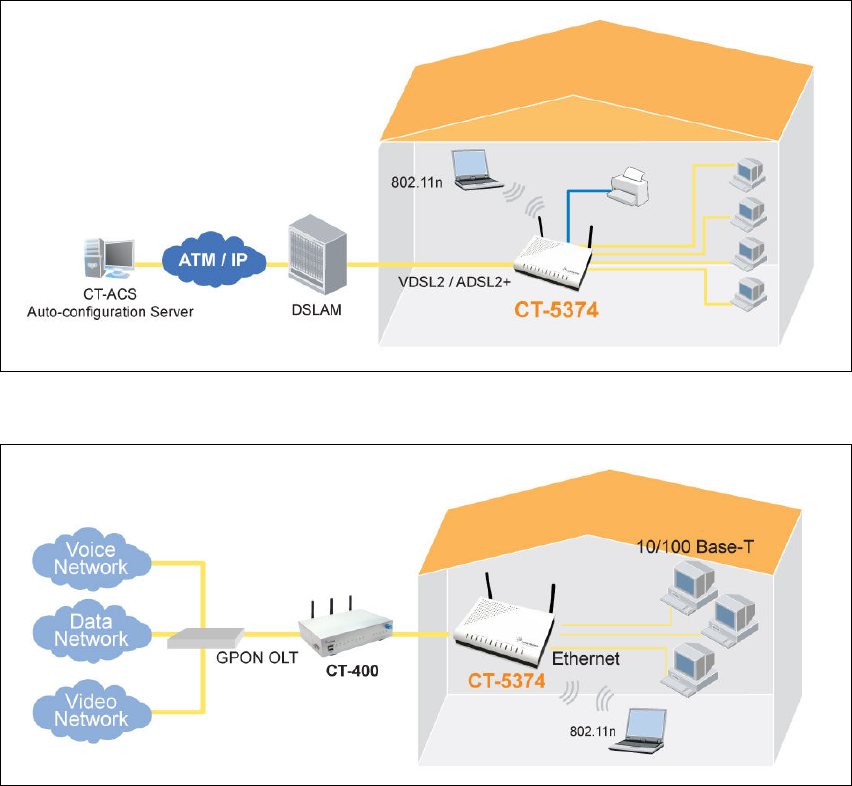
6
1.2 Application
The following diagrams depict typical applications of the CT-5374.
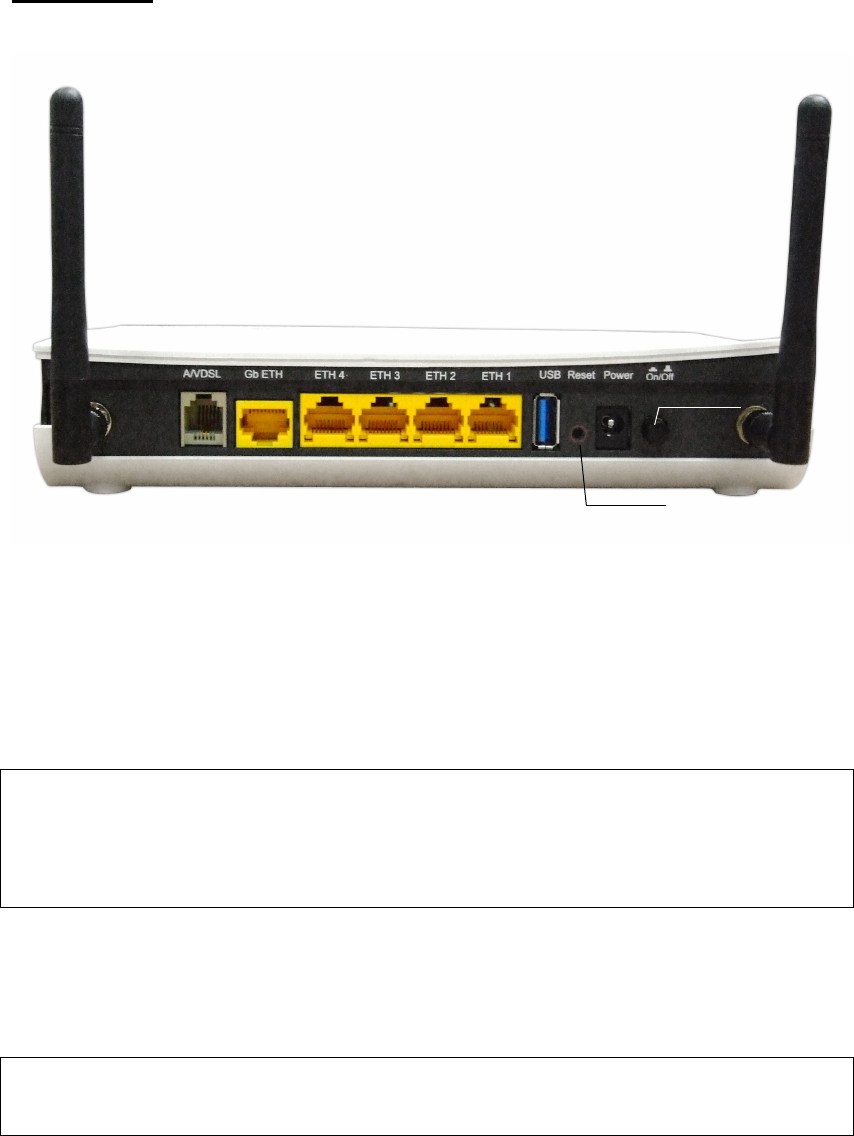
7
Chapter 2 Installation
2.1 Hardware Setup
Follow the instructions below to complete the hardware setup.
BACK PANEL
The figure below shows the back panel of the device.
Power ON
Press the power button to the OFF position (OUT). Connect the power adapter to the
power port. Attach the power adapter to a wall outlet or other AC source. Press the
power button to the ON position (IN). If the Power LED displays as expected then
the device is ready for setup (see section 2.2 LED Indicators).
Caution 1: If the device fails to power up, or it malfunctions, first verify that the
power cords are connected securely and then power it on again. If the
problem persists, contact technical support.
Caution 2: Before servicing or disassembling this equipment, disconnect all power
cords and telephone lines from their outlets.
Reset Button
Restore the default parameters of the device by pressing the Reset button for 5 to
10 seconds. After the device has rebooted successfully, the front panel should
display as expected (see section 2.2 LED Indicators for details).
NOTE: If pressed down for more than 20 seconds, the CT-5374 will go into a
firmware update state (CFE boot mode). The firmware can then be
updated using an Internet browser pointed to the default IP address.
Power Button
Reset Button
Power Port
Ethernet (LAN) Ports
Ethernet (LAN) Ports
A/VDSL Port
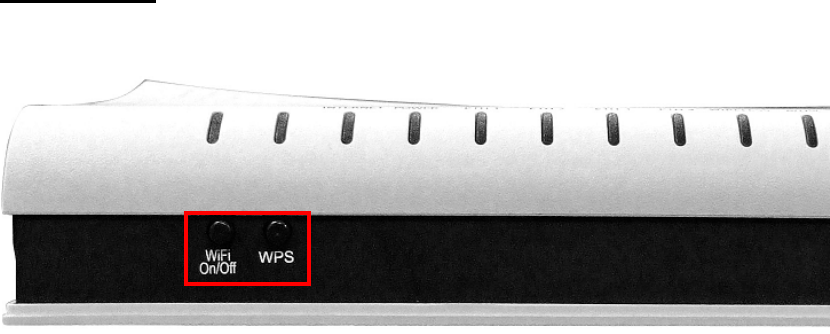
8
Ethernet (LAN) Ports
Use 10/100 BASE-T RJ-45 cables to connect up to four network devices. These ports
are auto-sensing MDI/X; so either straight-through or crossover cable can be used.
DSL Port
Connect to an ADSL2/2+ or VDSL with this RJ11 Port. This device contains a micro
filter which removes the analog phone signal. If you wish, you can connect a
regular telephone to the same line by using a POTS splitter.
FRONT PANEL
The Wi-Fi & WPS buttons are located on the bottom-left of the front panel, as shown.
WiFi Switch
Press this button to enable/disable the wireless LAN (WLAN).
WPS Button
Press this button to begin searching for WPS clients. These clients must also enable
WPS push button mode (see 6.2.1 WPS for instructions).
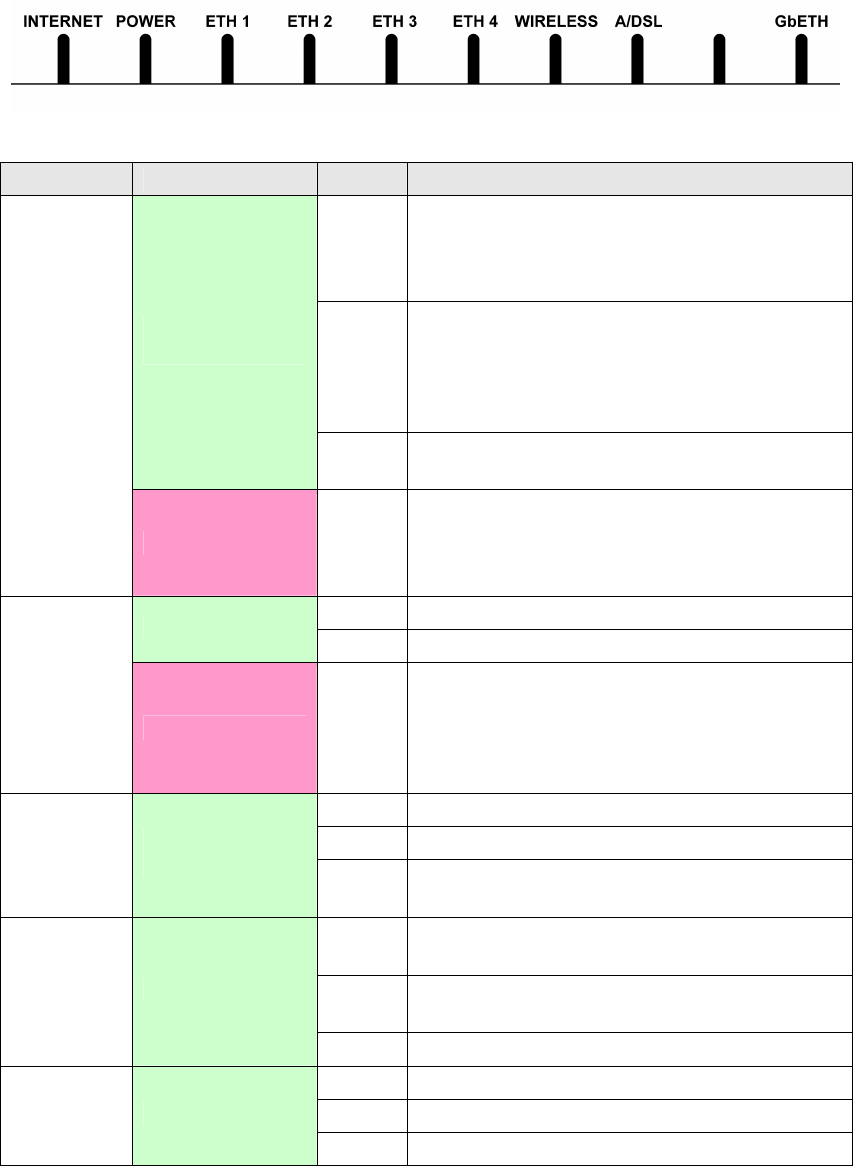
9
2.2 LED Indicators
The front panel LED indicators are shown below and explained in the following table.
This information can be used to check the status of the device and its connections.
LED Color Mode Function
On IP connected and no traffic detected. If
an IP or PPPoE session is dropped due to
an idle timeout, the light will remain green
if an ADSL connection is still present.
Off Modem power off, modem in bridged mode
or ADSL connection not present. In
addition, if an IP or PPPoE session is
dropped for any reason, other than an idle
timeout, the light is turned off.
Green
Blink IP connected and IP Traffic is passing thru
the device (either direction)
INTERNET
Red On
Device attempted to become IP connected
and failed (no DHCP response, no PPPoE
response, PPPoE authentication failed, no
IP address from IPCP, etc.)
On The device is powered up.
Green Off The device is powered down.
POWER
Red On
POST (Power On Self Test) failure or other
malfunction. A malfunction is any error of
internal sequence or state that will prevent
the device from connecting to the DSLAM
or passing customer data.
On An Ethernet Link is established.
Off An Ethernet Link is not established.
ETH 1X-4X
Green
Blink Data transmitting or receiving over
Ethernet.
On The wireless module is ready.
(i.e. installed and enabled).
Off The wireless module is not ready.
(i.e. either not installed or disabled).
WIRELESS
Green
Blink Data transmitting or receiving over WLAN.
On xDSL Link is established.
Off xDSL Link is not established.
A/DSL Green
Blink fast: xDSL Link is training or data
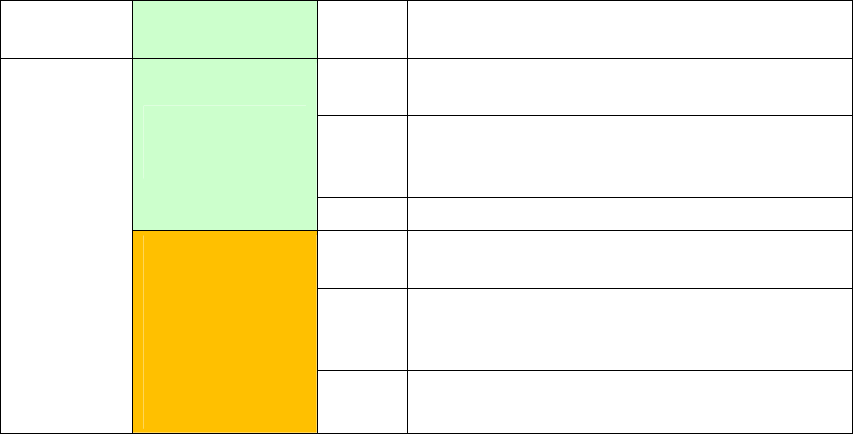
10
transmitting.
slow: xDSL training failed.
On Powered device connected to the
associated port.
Off No activity, modem powered off, no cable
or no powered device connected to the
associated port.
Green
(for 10/100
Base-T)
Blink Traffic is passing.
On Powered device connected to the
associated port.
Off
No activity, modem powered off, no cable
or no powered device connected to the
associated port.
GbETH
Amber
(for 10/100/1000
Base-T)
Blink Traffic is passing.

11
Chapter 3 Web User Interface
This section describes how to access the device via the web user interface (WUI)
using an Internet browser such as Internet Explorer (version 5.0 and later).
3.1 Default Settings
The factory default settings of this device are summarized below.
• LAN IP address: 192.168.1.1
• LAN subnet mask: 255.255.255.0
• Administrative access (username: root , password: 12345)
• User access (username: user, password: user)
• Remote (WAN) access (username: support, password: support)
• WLAN access: enabled
Technical Note
During power on, the device initializes all settings to default values. It will then
read the configuration profile from the permanent storage section of flash memory.
The default attributes are overwritten when identical attributes with different values
are configured. The configuration profile in permanent storage can be created via
the web user interface or telnet user interface, or other management protocols.
The factory default configuration can be restored either by pushing the reset button
for more than five seconds until the power indicates LED blinking or by clicking the
Restore Default Configuration option in the Restore Settings screen.
3.2 IP Configuration
DHCP MODE
When the CT-5374 powers up, the onboard DHCP server will switch on. Basically, the
DHCP server issues and reserves IP addresses for LAN devices, such as your PC.
To obtain an IP address from the DCHP server, follow the steps provided below.
NOTE: The following procedure assumes you are running Windows XP.
However, the general steps involved are similar for most operating
systems (OS). Check your OS support documentation for further details.
STEP 1: From the Network Connections window, open Local Area Connection (You
may also access this screen by double-clicking the Local Area Connection
icon on your taskbar). Click the Properties button.
STEP 2: Select Internet Protocol (TCP/IP) and click the Properties button.
STEP 3: Select Obtain an IP address automatically as shown below.
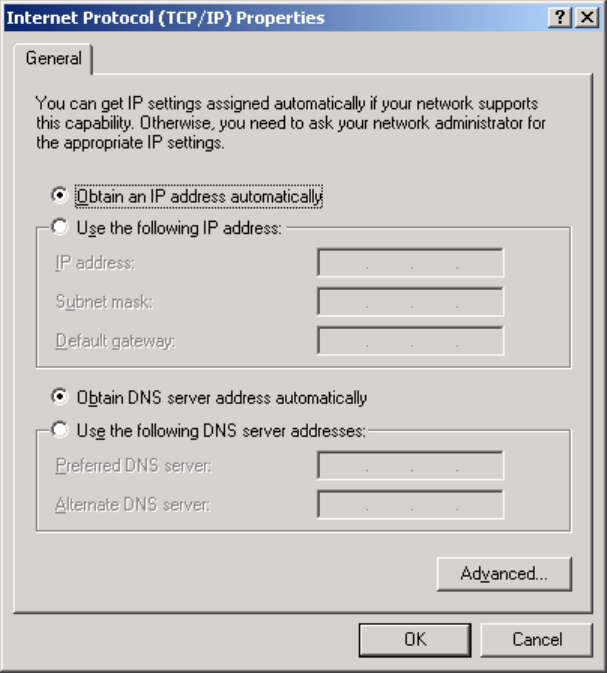
12
STEP 4: Click OK to submit these settings.
If you experience difficulty with DHCP mode, you can try static IP mode instead.
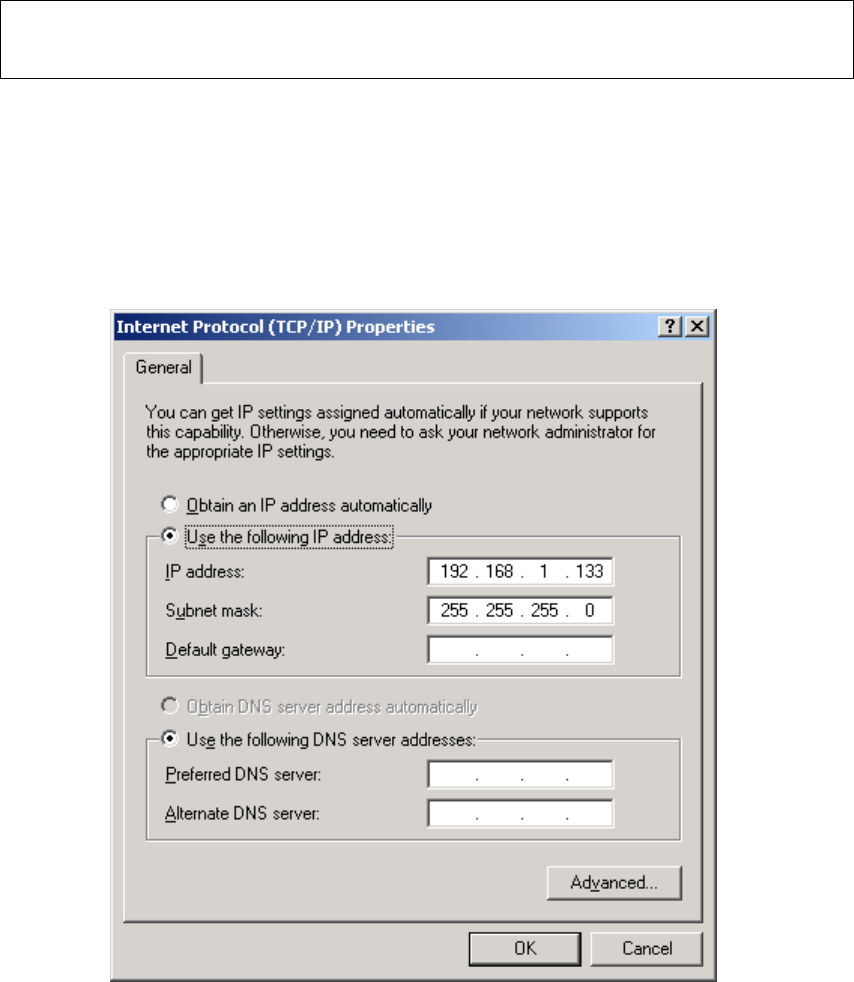
13
STATIC IP MODE
In static IP mode, you assign IP settings to your PC manually.
Follow these steps to configure your PC IP address to use subnet 192.168.1.x.
NOTE: The following procedure assumes you are running Windows XP.
However, the general steps involved are similar for most operating
systems (OS). Check your OS support documentation for further details.
STEP 1: From the Network Connections window, open Local Area Connection (You
may also access this screen by double-clicking the Local Area Connection
icon on your taskbar). Click the Properties button.
STEP 2: Select Internet Protocol (TCP/IP) and click the Properties button.
STEP 3: Change the IP address to the 192.168.1.x (1<x<255) subnet with subnet
mask of 255.255.255.0. The screen should now display as shown below.
STEP 4: Click OK to submit these settings.
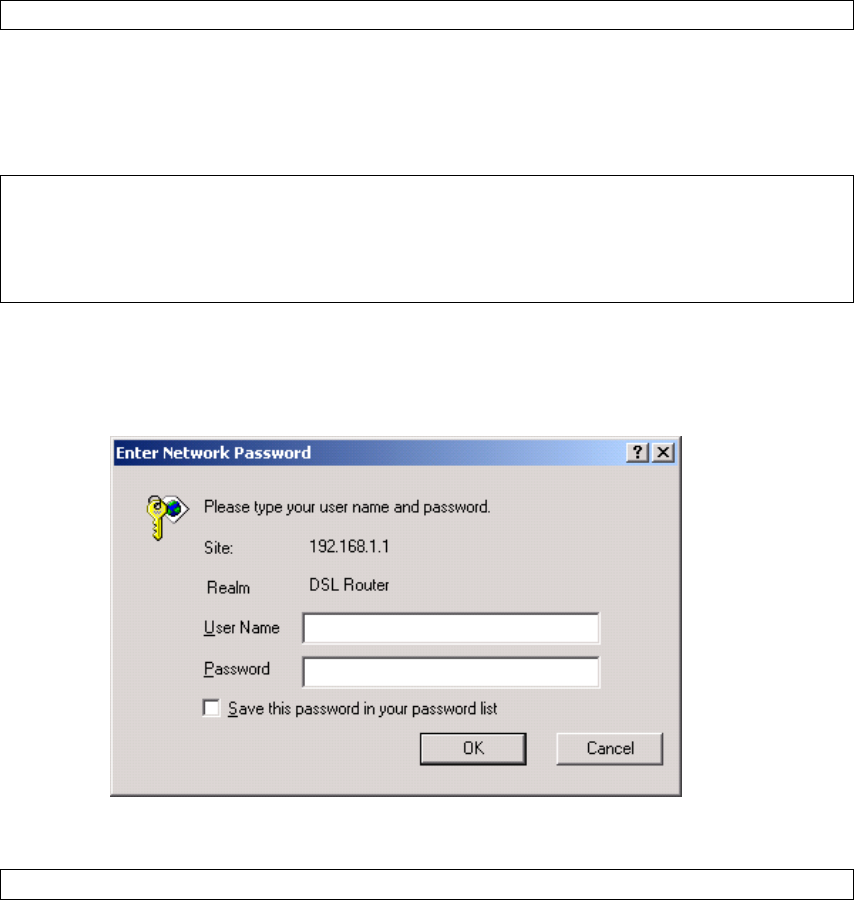
14
3.3 Login Procedure
Perform the following steps to login to the web user interface.
NOTE: The default settings can be found in 3.1 Default Settings.
STEP 1: Start the Internet browser and enter the default IP address for the device
in the Web address field. For example, if the default IP address is
192.168.1.1, type http://192.168.1.1.
NOTE: For local administration (i.e. LAN access), the PC running the browser
must be attached to the Ethernet, and not necessarily to the device.
For remote access (i.e. WAN), use the IP address shown on the Chapter 4
Device Information screen and login with remote username and
password.
STEP 2: A dialog box will appear, such as the one below. Enter the default
username and password, as defined in section 3.1 Default Settings.
Click OK to continue.
NOTE: The login password can be changed later (see 8.6.1 Passwords).
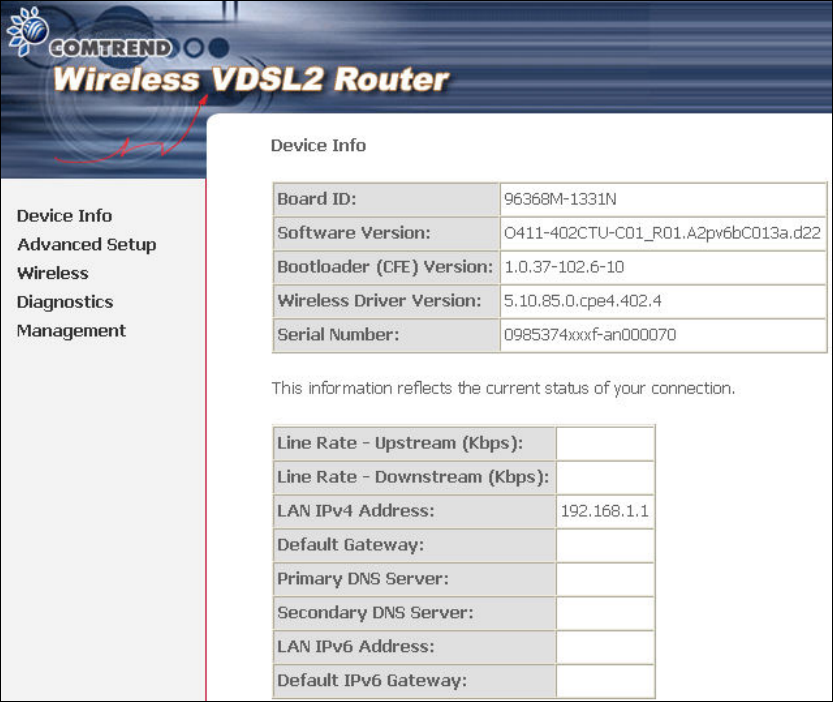
15
STEP 3: After successfully logging in for the first time, you will reach this screen.
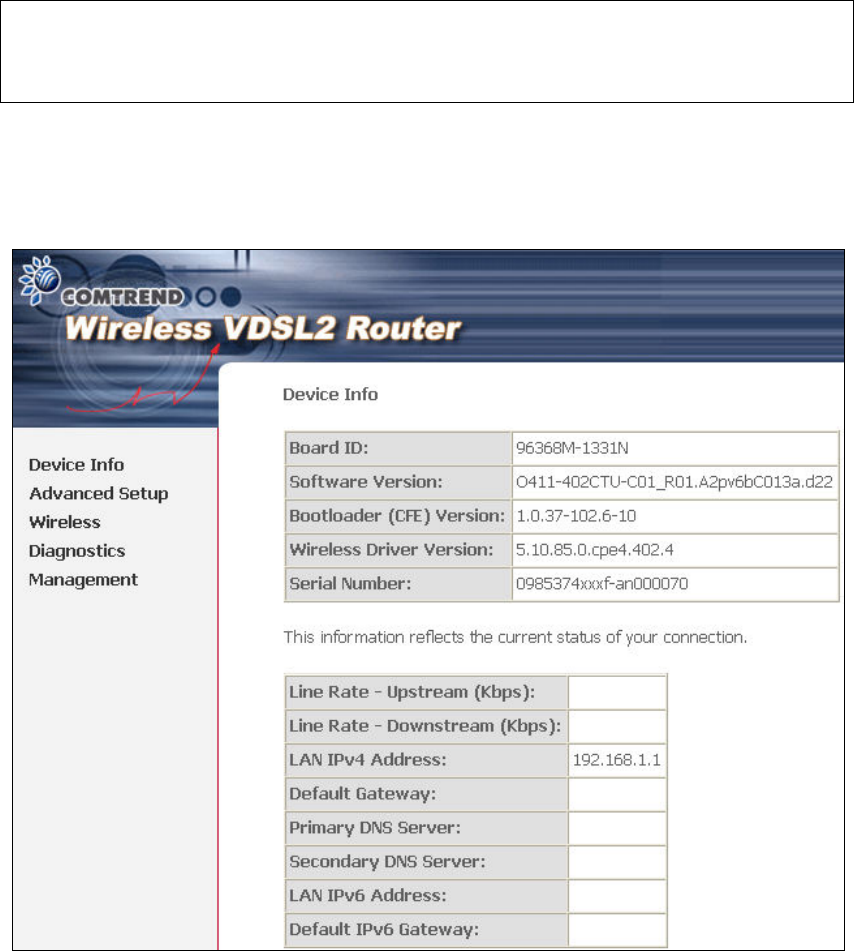
16
Chapter 4 Device Information
The web user interface window is divided into two frames, the main menu (at left)
and the display screen (on the right). The main menu has several options and
selecting each of these options opens a submenu with more selections.
NOTE: The menu items shown are based upon the configured connection(s) and
user account privileges. For example, if NAT and Firewall are enabled, the
main menu will display the NAT and Security submenus. If either is
disabled, their corresponding menu(s) will also be disabled.
Device Info is the first selection on the main menu so it will be discussed first.
Subsequent chapters will introduce the other main menu options in sequence.
The Device Info Summary screen displays at startup.
This screen shows hardware, software, IP settings and other related information.
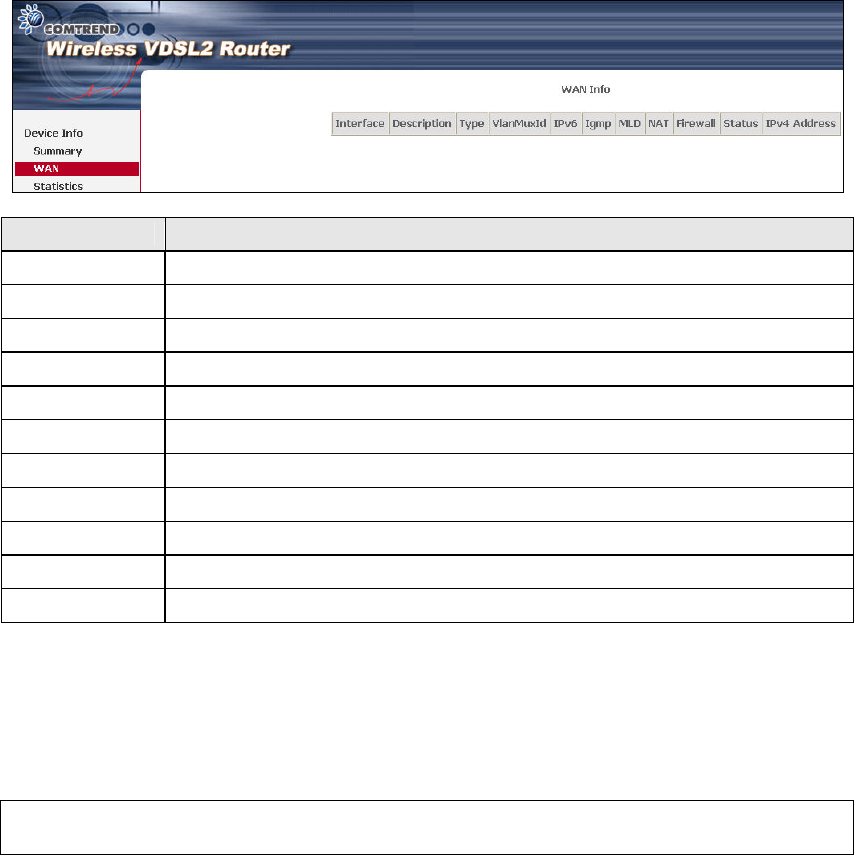
17
4.1 WAN
Select WAN from the Device Info submenu to display the configured PVC(s).
Heading Description
Interface Name of the interface for WAN
Description Name of the WAN connection
Type Shows the connection type
VlanMuxId Shows 802.1Q VLAN ID
IPv6 Shows WAN IPv6 address
IGMP Shows Internet Group Management Protocol (IGMP) status
MLD Shows Multicast Listener Discovery (MLD) status
NAT Shows Network Address Translation (NAT) status
Firewall Shows the status of Firewall
Status Lists the status of DSL link
IPv4 Address Shows WAN IPv4 address
4.2 Statistics
This selection provides LAN, WAN, ATM/PTM and xDSL statistics.
NOTE: These screens are updated automatically every 15 seconds.
Click Reset Statistics to perform a manual update.
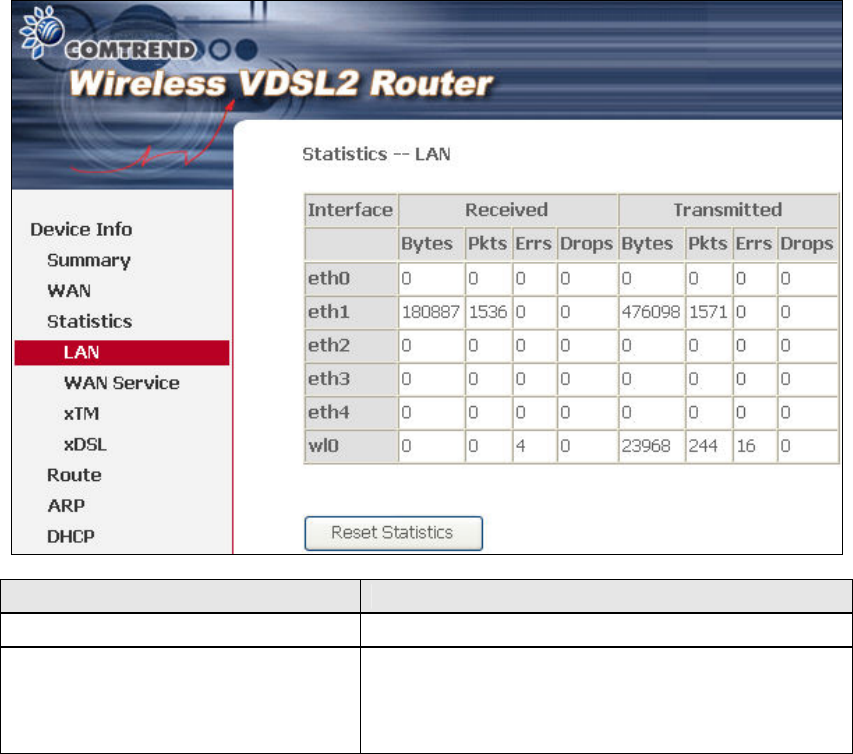
18
4.2.1 LAN Statistics
This screen shows data traffic statistics for each LAN interface.
Heading Description
Interface LAN interface(s)
Received/Transmitted: - Bytes
- Pkts
- Errs
- Drops
Number of Bytes
Number of Packets
Number of packets with errors
Number of dropped packets
4.2.2 WAN Statistics
This screen shows data traffic statistics for each WAN interface.
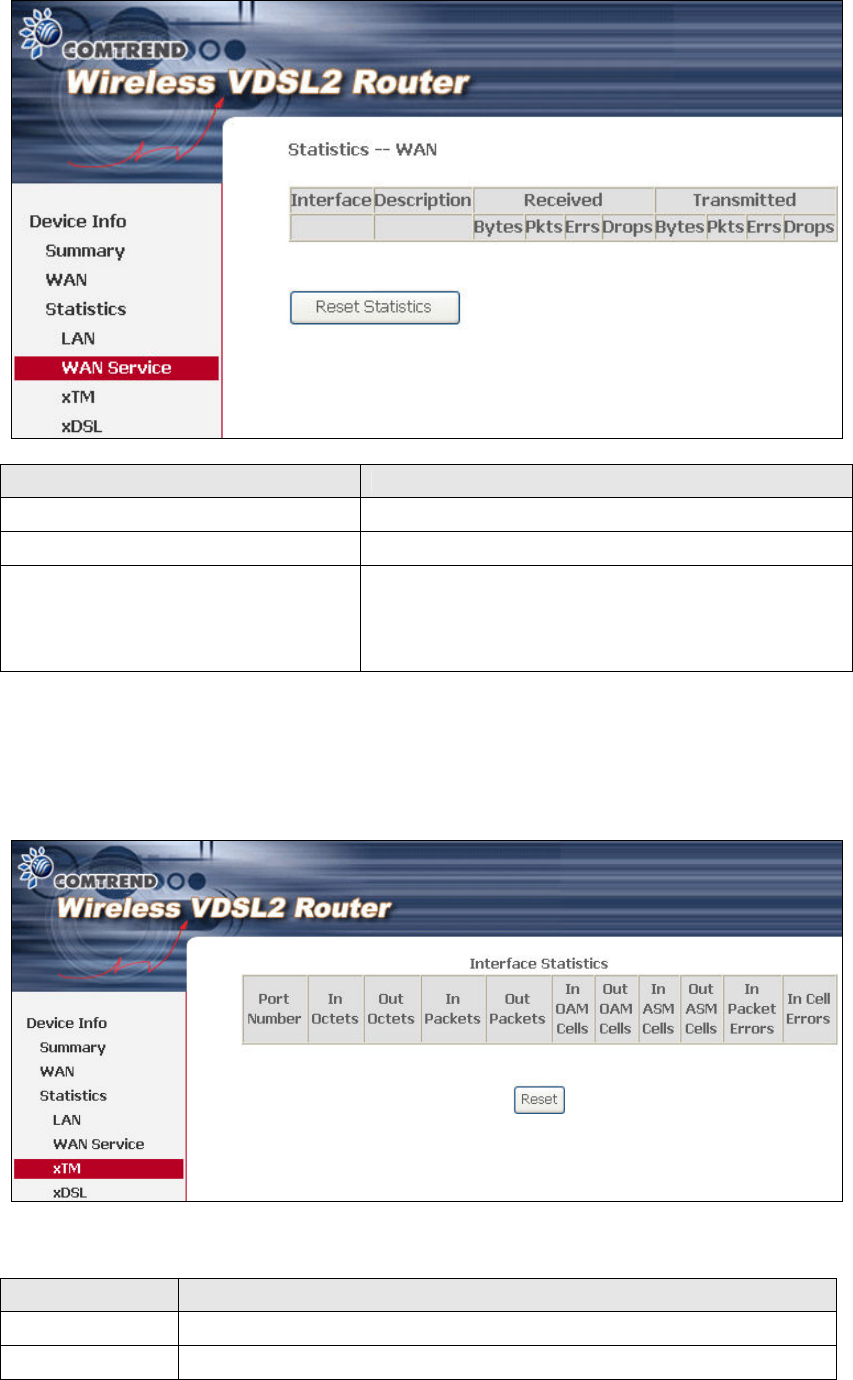
19
Heading Description
Interface WAN interfaces
Description WAN service label
Received/Transmitted - Bytes
- Pkts
- Errs
- Drops
Number of Bytes
Number of Packets
Number of packets with errors
Number of dropped packets
4.2.3 ATM Statistics
The following figure shows Asynchronous Transfer Mode (ATM) statistics.
ATM Interface Statistics
Heading Description
Port Number ATM PORT (0-3)
In Octets Number of received octets over the interface

20
Heading Description
Out Octets Number of transmitted octets over the interface
In Errors Number of cells dropped due to uncorrectable HEC errors
In Unknown Number of received cells discarded during cell header validation,
including cells with unrecognized VPI/VCI values, and cells with
invalid cell header patterns. If cells with undefined PTI values
are discarded, they are also counted here.
In Hec Errors Number of cells received with an ATM Cell Header HEC error
In Invalid Vpi
Vci Errors
Number of cells received with an unregistered VCC address.
In Port Not
Enable Errors
Number of cells received on a port that has not been enabled.
In PTI Errors Number of cells received with an ATM header Payload Type
Indicator (PTI) error
In Idle Cells Number of idle cells received
In Circuit Type
Errors
Number of cells received with an illegal circuit type
In OAM RM CRC
Errors
Number of OAM and RM cells received with CRC errors
In GFC Errors Number of cells received with a non-zero GFC.
AAL5 Interface Statistics
Heading Description
In Octets Number of received AAL5/AAL0 CPCS PDU octets
Out Octets Number of received AAL5/AAL0 CPCS PDU octets transmitted
In Ucast Pkts Number of received AAL5/AAL0 CPCS PDUs passed to a
higher-layer for transmission
Out Ucast Pkts Number of received AAL5/AAL0 CPCS PDUs received from a
higher layer for transmission
In Errors Number of received AAL5/AAL0 CPCS PDUs received that
contain an error. These errors include CRC-32 errors.
Out Errors Number of received AAL5/AAL0 CPCS PDUs that could not be
transmitted due to errors.
In Discards Number of received AAL5/AAL0 CPCS PDUs discarded due to an
input buffer overflow condition.
Out Discards This field is not currently used
AAL5 VCC Statistics
Heading Description
VPI/VCI ATM Virtual Path/Channel Identifiers
CRC Errors Number of PDUs received with CRC-32 errors
SAR Timeouts Number of partially re-assembled PDUs that were discarded
because they were not fully re-assembled within the required
period of time. If the re-assembly time is not supported, then
this object contains a zero value.
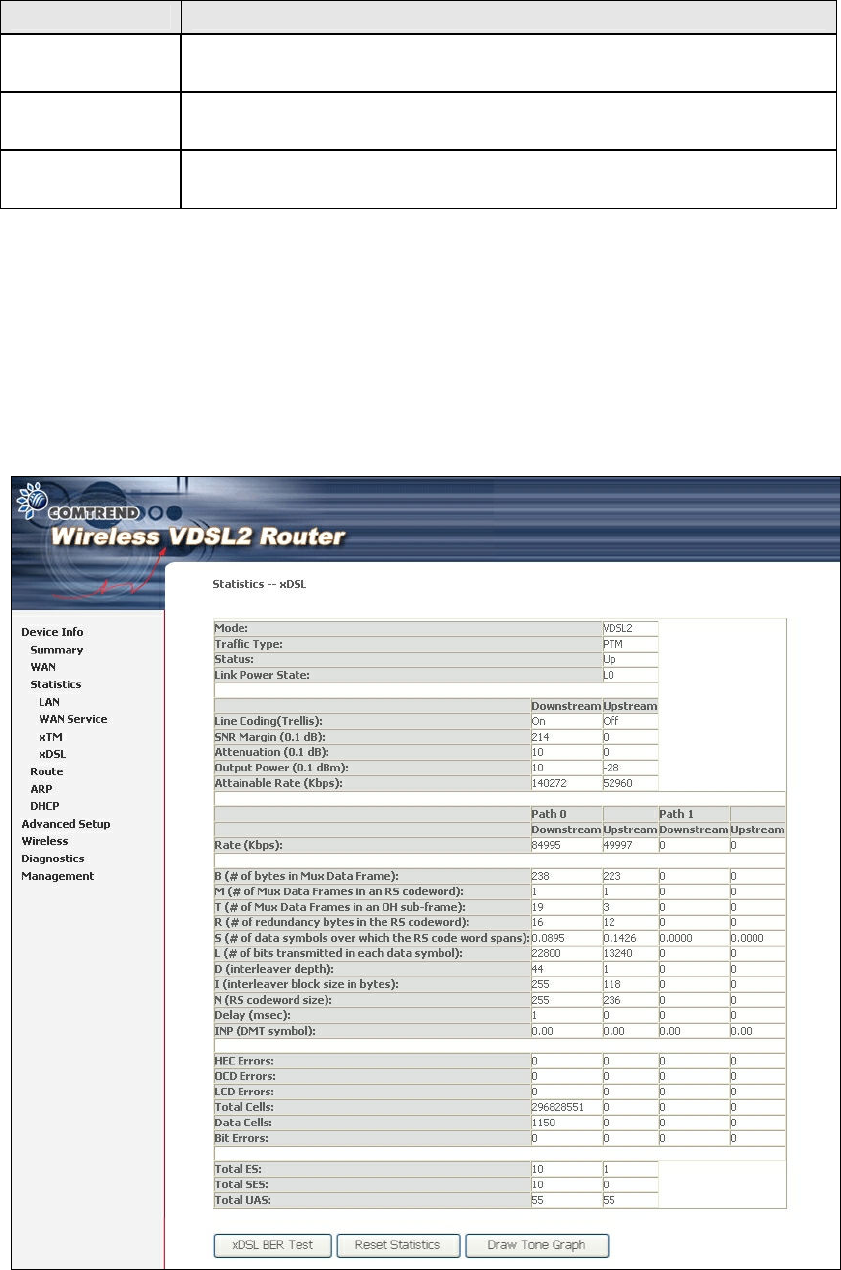
21
Heading Description
Oversized SDUs
Number of PDUs discarded because the corresponding SDU was
too large
Short Packet
Errors
Number of PDUs discarded because the PDU length was less
than the size of the AAL5 trailer
Length Errors Number of PDUs discarded because the PDU length did not
match the length in the AAL5 trailer
4.2.4 xDSL Statistics
The xDSL Statistics screen displays information corresponding to the xDSL type.
The two examples below (VDSL & ADSL) show this variation.
VDSL
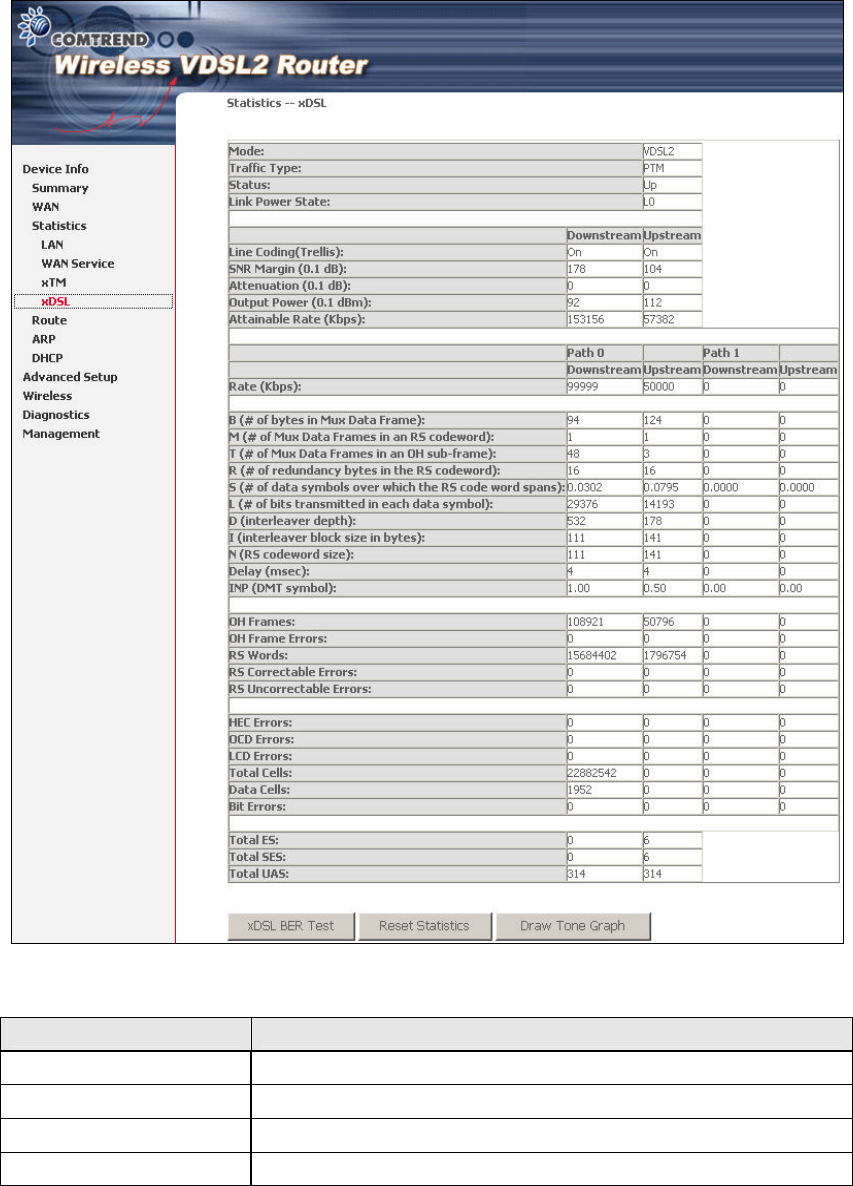
22
ADSL
Click the Reset Statistics button to refresh this screen.
Field Description
Mode G.Dmt, G.lite, T1.413, ADSL2, ADSL2+,VDSL, VDSL2
Traffic Type Channel type Interleave or Fast
Status Lists the status of the DSL link
Link Power State Link output power state.

23
Line Coding (Trellis) Trellis On/Off
SNR Margin (0.1 dB) Signal to Noise Ratio (SNR) margin
Attenuation (0.1 dB) Estimate of average loop attenuation in the downstream
direction.
Output Power
(0.1 dBm)
Total upstream output power
Attainable Rate (Kbps)
The sync rate you would obtain.
Rate (Kbps) Current sync rates downstream/upstream
In VDSL mode, the following section is inserted.
B Number of bytes in Mux Data Frame
M Number of Mux Data Frames in a RS codeword
T Number of Mux Data Frames in an OH sub-frame
R Number of redundancy bytes in the RS codeword
S Number of data symbols the RS codeword spans
L Number of bits transmitted in each data symbol
D The interleaver depth
I The interleaver block size in bytes
N RS codeword size
Delay The delay in milliseconds (msec)
INP DMT symbol
In ADSL2+ mode, the following section is inserted.
MSGc Number of bytes in overhead channel message
B Number of bytes in Mux Data Frame
M Number of Mux Data Frames in FEC Data Frame
T Mux Data Frames over sync bytes
R Number of check bytes in FEC Data Frame
S Ratio of FEC over PMD Data Frame length
L Number of bits in PMD Data Frame
D The interleaver depth
Delay The delay in milliseconds (msec)
INP DMT symbol
In G.DMT mode, the following section is inserted.
K Number of bytes in DMT frame
R Number of check bytes in RS code word
S RS code word size in DMT frame
D The interleaver depth
Delay The delay in milliseconds (msec)
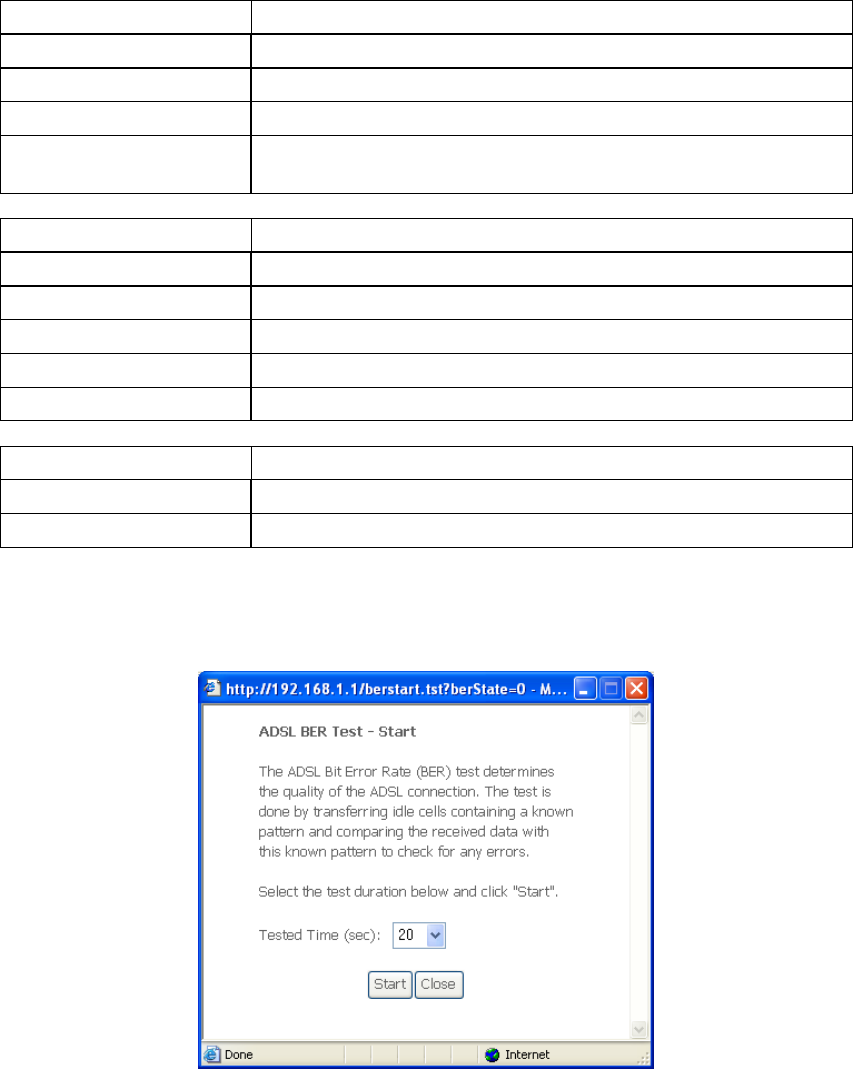
24
OH Frames Total number of OH frames
OH Frame Errors Number of OH frames received with errors
RS Words Total number of Reed-Solomon code errors
RS Correctable Errors Total Number of RS with correctable errors
RS Uncorrectable
Errors
Total Number of RS words with uncorrectable errors
HEC Errors Total Number of Header Error Checksum errors
OCD Errors Total Number of Out-of-Cell Delineation errors
LCD Errors Total number of Loss of Cell Delineation
Total Cells Total number of ATM cells (including idle + data cells)
Data Cells Total number of ATM data cells
Bit Errors Total number of bit errors
Total ES Total Number of Errored Seconds
Total SES Total Number of Severely Errored Seconds
Total UAS Total Number of Unavailable Seconds
xDSL BER TEST
Click xDSL BER Test on the xDSL Statistics screen to test the Bit Error Rate (BER).
A small pop-up window will open after the button is pressed, as shown below.
Click Start to start the test or click Close to cancel the test. After the BER testing is
complete, the pop-up window will display as follows.
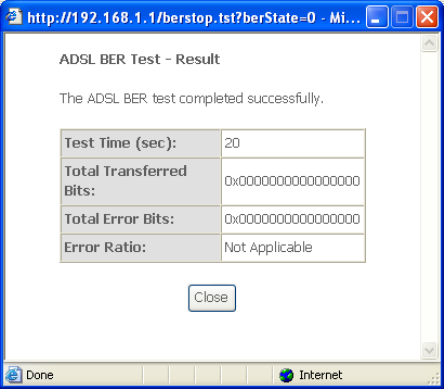
25
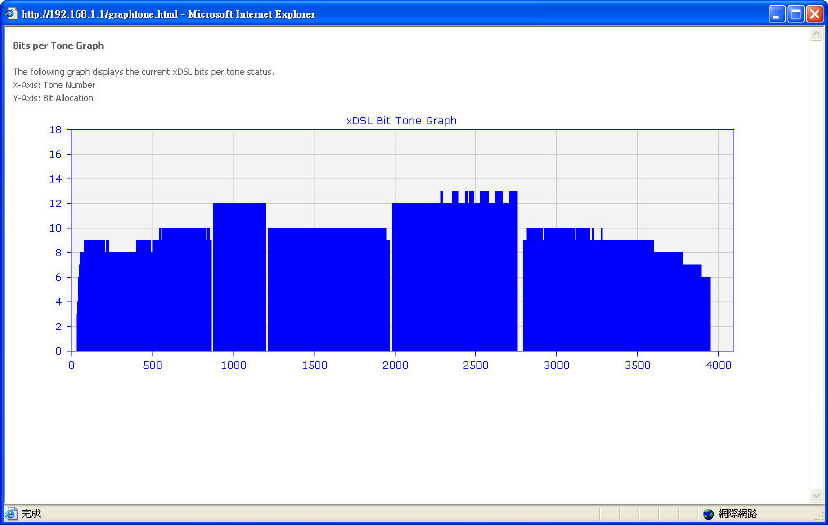
26
xDSL TONE GRAPH
Click Draw Tone Graph on the xDSL Statistics screen and a pop-up window will
display the xDSL bits per tone status, as shown below.
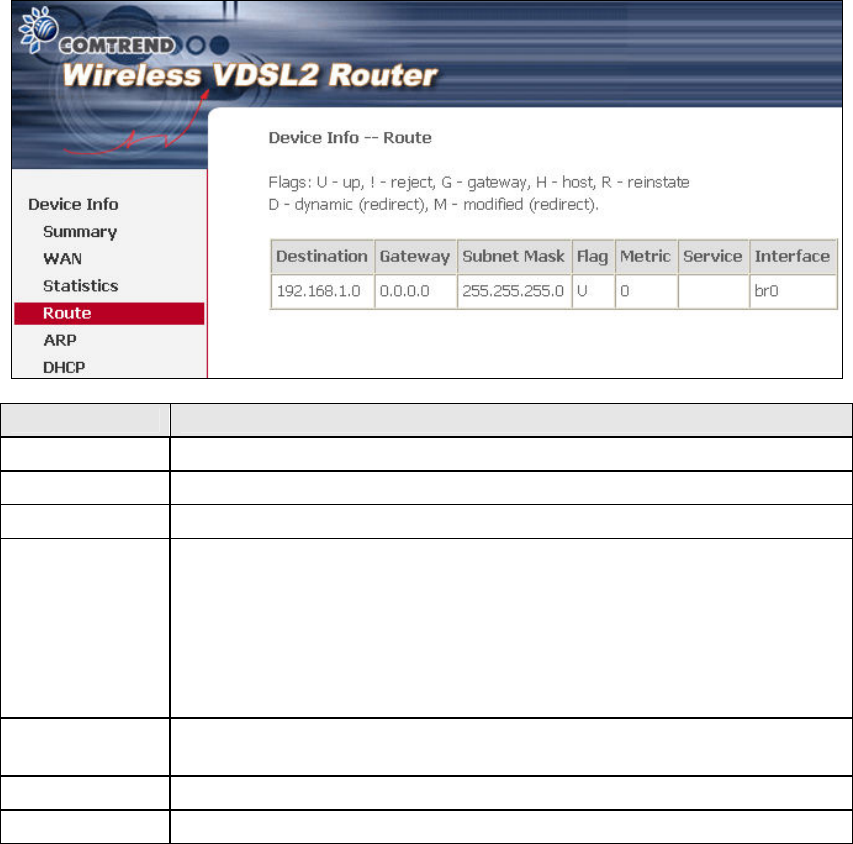
27
4.3 Route
Choose Route to display the routes that the CT-5374 has found.
Field Description
Destination Destination network or destination host
Gateway Next hub IP address
Subnet Mask Subnet Mask of Destination
Flag U: route is up
!: reject route
G: use gateway
H: target is a host
R: reinstate route for dynamic routing
D: dynamically installed by daemon or redirect
M: modified from routing daemon or redirect
Metric The 'distance' to the target (usually counted in hops). It is not
used by recent kernels, but may be needed by routing daemons.
Service Shows the WAN connection label
Interface Shows connection interfaces
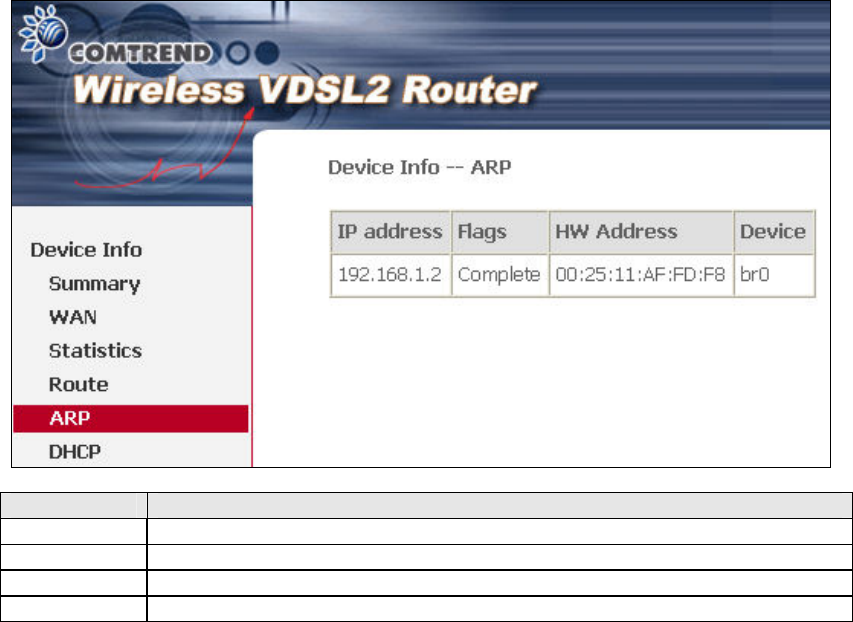
28
4.4 ARP
Click ARP to display the ARP information.
Field Description
IP address Shows IP address of host pc
Flags Complete, Incomplete, Permanent, or Publish
HW Address
Shows the MAC address of host pc
Device Shows the connection interface
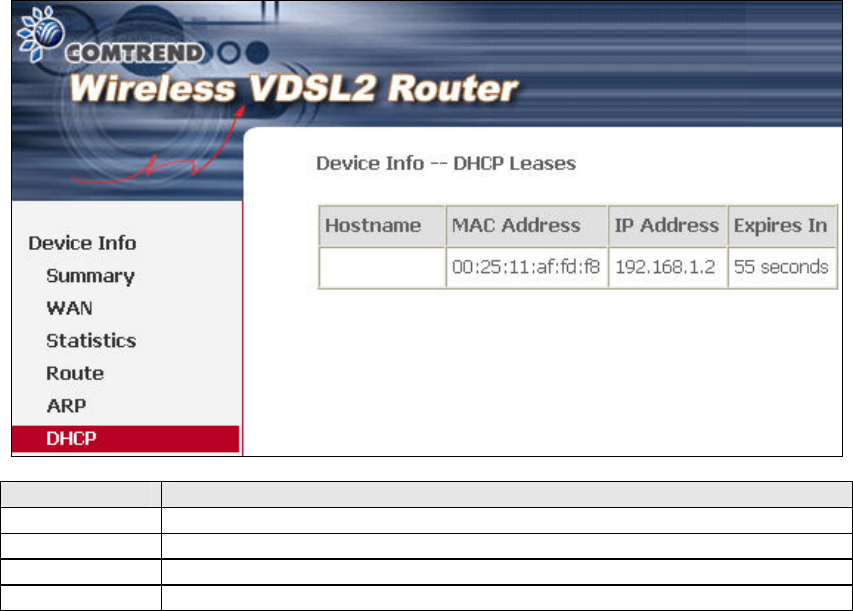
29
4.5 DHCP
Click DHCP to display all DHCP Leases.
Field Description
Hostname Shows the device/host/PC network name
MAC Address Shows the Ethernet MAC address of the device/host/PC
IP Address Shows IP address of device/host/PC
Expires In Shows how much time is left for each DHCP Lease
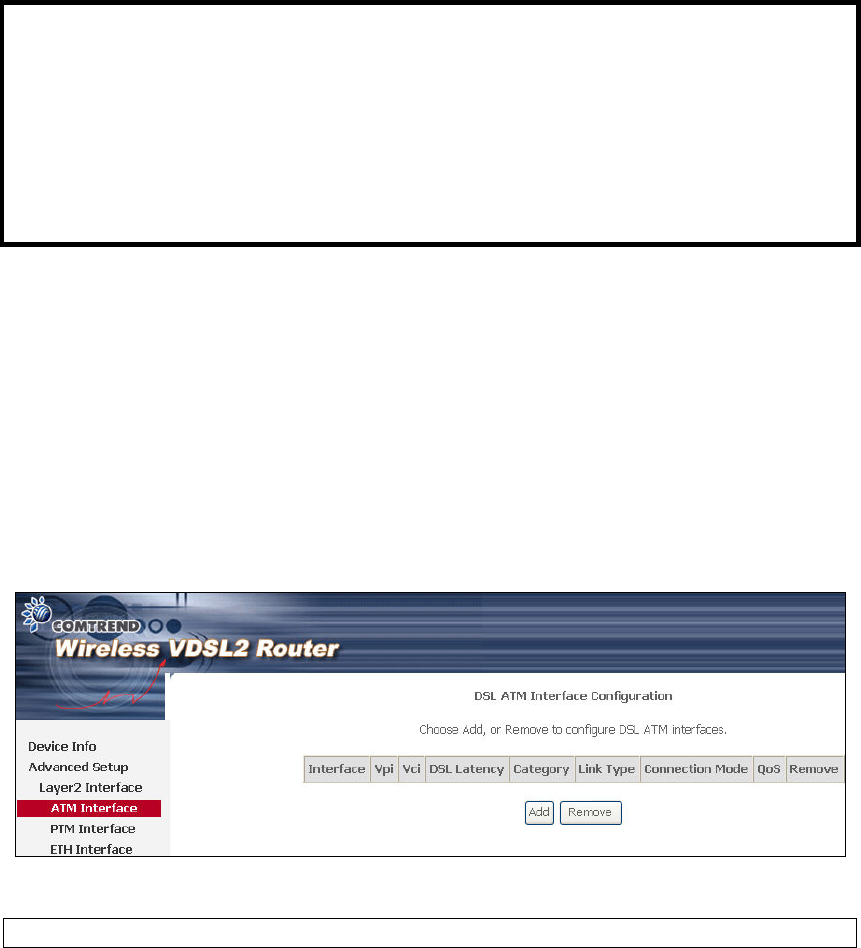
30
Chapter 5 Advanced Setup
Click on the link to jump to a specific section:
5.1 Layer 2 Interface 5.9 Routing
5.2 WAN 5.10 DNS
5.3 LAN 5.11 DSL
5.4 IPv6 LAN Host 5.12 UPnP
5.5 NAT 5.13 Print Server
5.6 Security 5.14 Interface Grouping
5.7 Parental Control 5.15 Certificate
5.8 Quality of Service (QoS) 5.16 Power Management
5.1 Layer 2 Interface
The ATM, PTM and ETH WAN interface screens are described here.
5.1.1 ATM Interface
Add or remove ATM interface connections here.
Click Add to create a new ATM interface (see Appendix G).
NOTE: Up to 8 ATM interfaces can be created and saved in flash memory.
To remove a connection, select its Remove column radio button and click Remove.
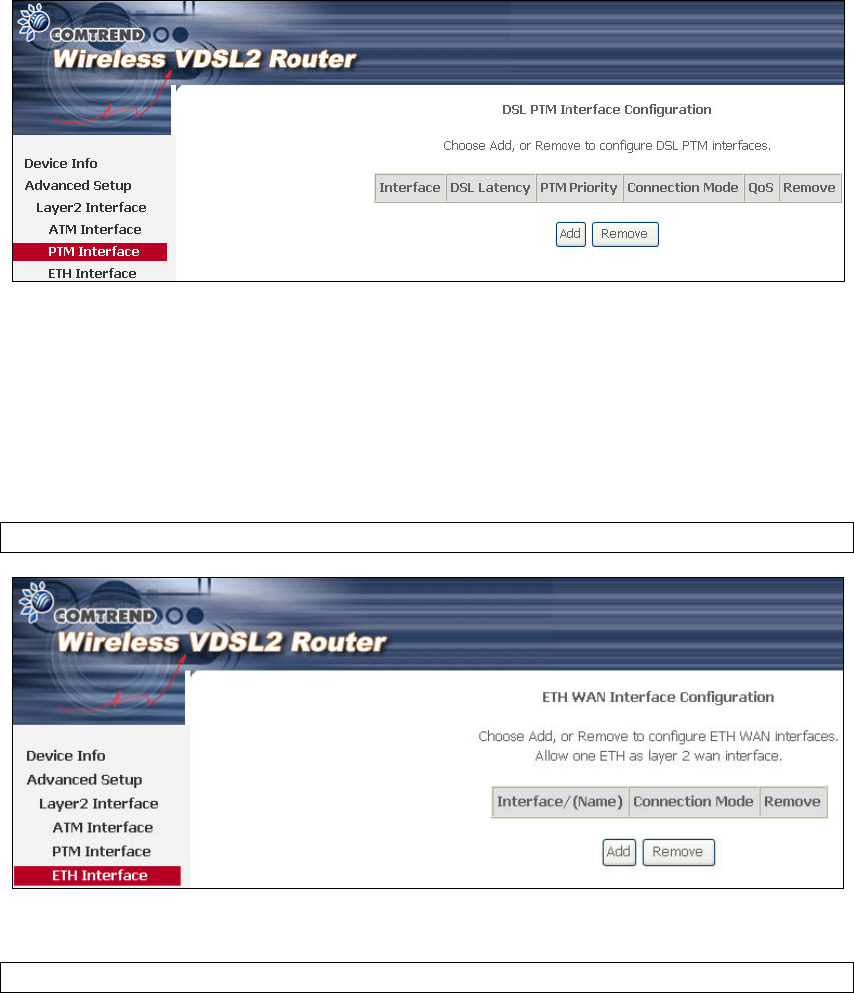
31
5.1.2 PTM Interface
Add or remove PTM interface connections here.
Click Add to create a new connection (see Appendix G - Connection Setup). To
remove a connection, select its Remove column radio button and click Remove.
5.1.3 ETH WAN INTERFACE
This screen displays the Ethernet WAN Interface configuration.
NOTE: This option only applies to models with an Ethernet WAN port.
Click Add to create a new connection (see Appendix G - Connection Setup).
NOTE: One Ethernet WAN interface can be created and saved in flash memory.
To remove a connection, select its Remove column radio button and click remove.
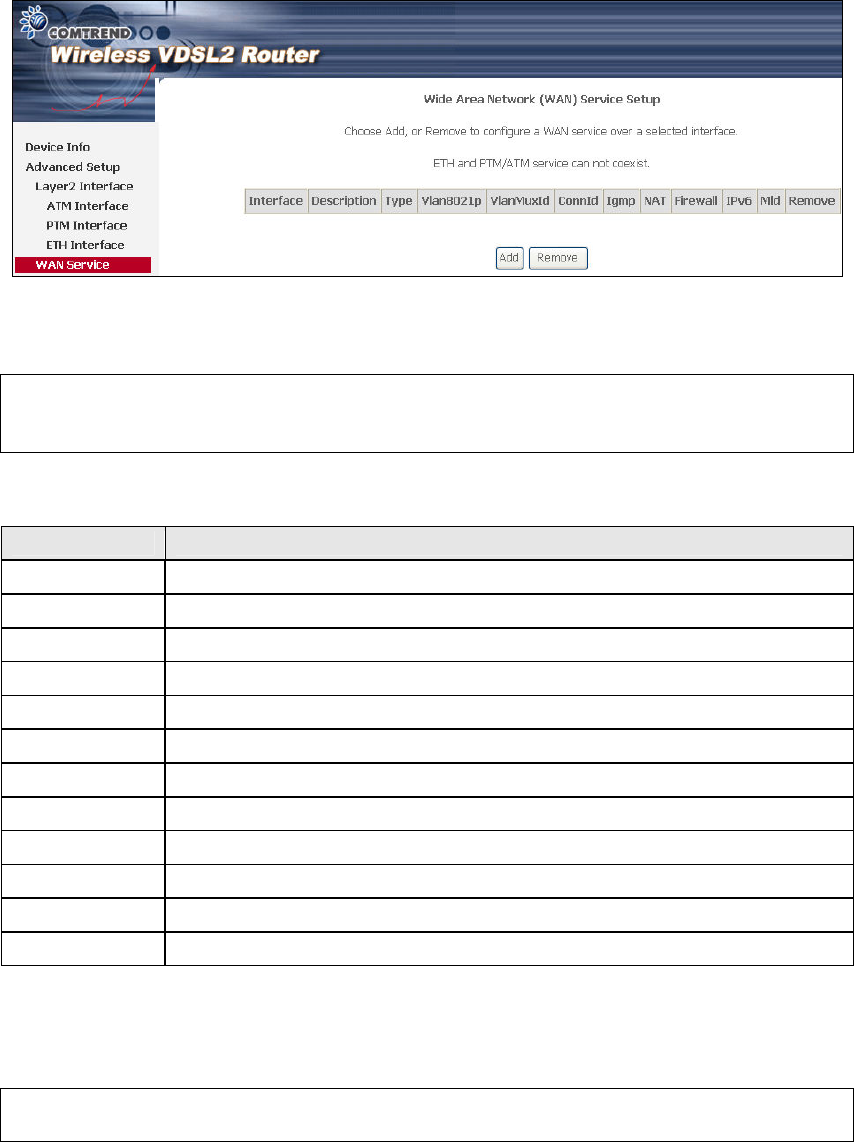
32
5.2 WAN
This screen allows for the configuration of WAN interfaces.
Click the Add button to create a new connection. For connections on ATM or ETH
WAN interfaces see Appendix G - Connection Setup.
NOTE: ETH and ATM service connections cannot coexist. In Default Mode, up to
8 WAN connections can be configured; while VLAN Mux and MSC
Connection Modes support up to 16 WAN connections.
To remove a connection, select its Remove column radio button and click Remove.
Heading Description
Interface Name of the interface for WAN
Description Name of the WAN connection
Type Shows the connection type
Vlan8021p VLAN ID is used for VLAN Tagging (IEEE 802.1Q)
VlanMuxId Shows 802.1Q VLAN ID
ConnId Connection ID
IGMP Shows Internet Group Management Protocol (IGMP) status
NAT Shows Network Address Translation (NAT) status
Firewall Shows the Security status
IPv6 Shows the WAN IPv6 address
MLD Shows Multicast Listener Discovery (MLD) status
Remove Select interfaces to remove
To remove a connection, select its Remove column radio button and click Remove.
To Add a new WAN connection, click the Add button and follow the instructions.
NOTE: Up to 16 PVC profiles can be configured and saved in flash memory.
Also, ETH and PTM/ATM service connections cannot coexist.
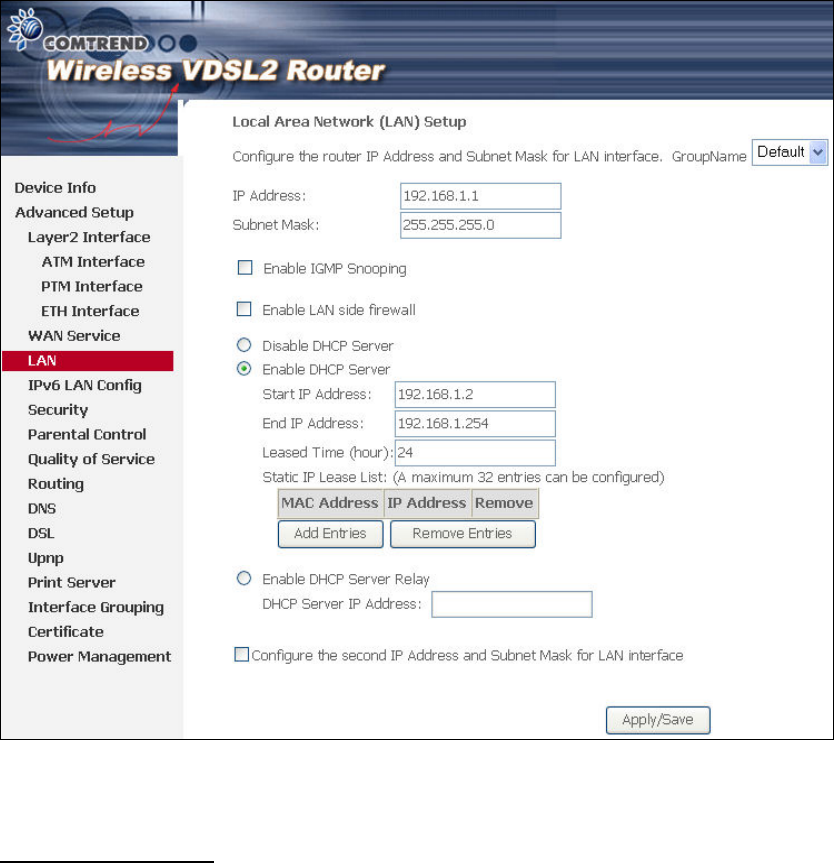
33
5.3 LAN
Configure the LAN interface settings and then click Apply/Save.
Consult the field descriptions below for more details.
GroupName: Select an Interface Group.
1
st
LAN INTERFACE
IP Address: Enter the IP address for the LAN port.
Subnet Mask: Enter the subnet mask for the LAN port.
Enable IGMP Snooping: Enable by ticking the checkbox .
Standard Mode: In standard mode, multicast traffic will flood to all
bridge ports when no client subscribes to a multicast
group – even if IGMP snooping is enabled.
Blocking Mode: In blocking mode, the multicast data traffic will be
blocked and not flood to all bridge ports when there are
no client subscriptions to any multicast group.
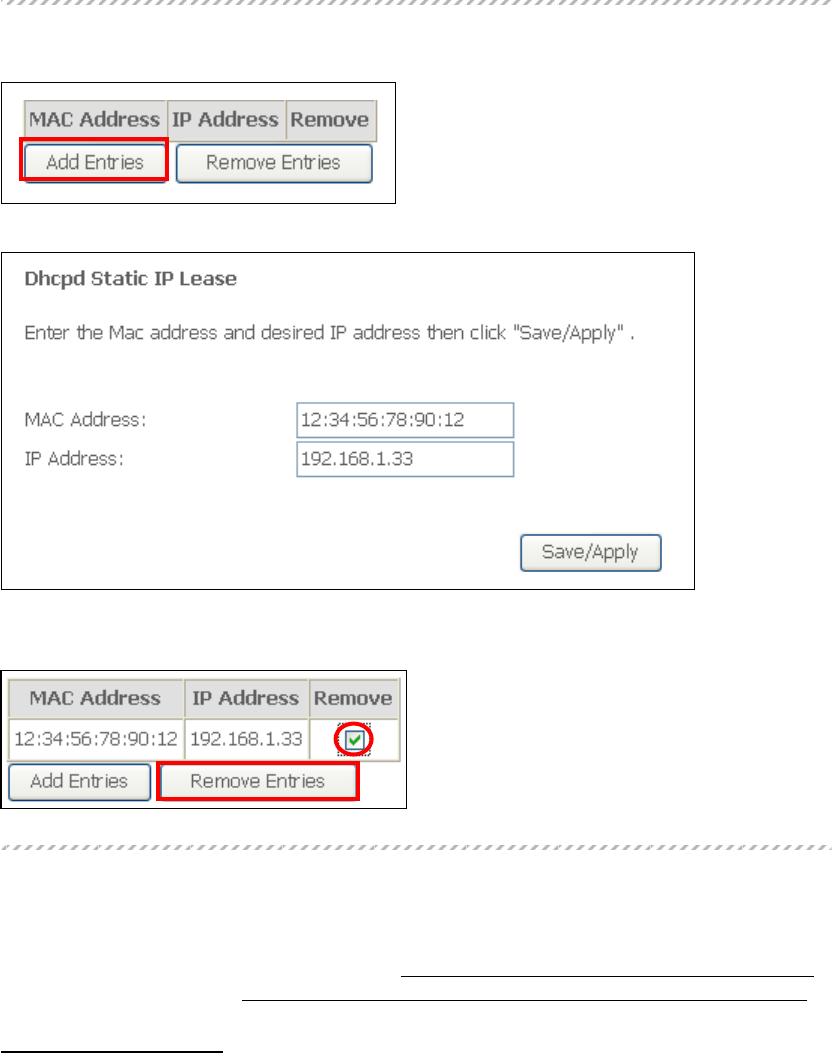
34
Enable LAN side firewall: Enable by ticking the checkbox .
DHCP Server: To enable DHCP, select Enable DHCP server and enter Start and
End IP addresses and the Leased Time. This setting configures the
router to automatically assign IP, default gateway and DNS server
addresses to every PC on your LAN.
Static IP Lease List: A maximum of 32 entries can be configured.
To add an entry, enter MAC address and Static IP and then click Save/Apply.
To remove an entry, tick the corresponding checkbox in the Remove column and
then click the Remove Entries button, as shown below.
DHCP Server Relay: Enable with checkbox and enter DHCP Server IP address.
This allows the Router to relay the DHCP packets to the
remote DHCP server. The remote DHCP server will provide
the IP address. This option is hidden if NAT is enabled or
when the router is configured with only one Bridge PVC.
2
ND
LAN INTERFACE
To configure a secondary IP address, tick the checkbox outlined (in RED) below.
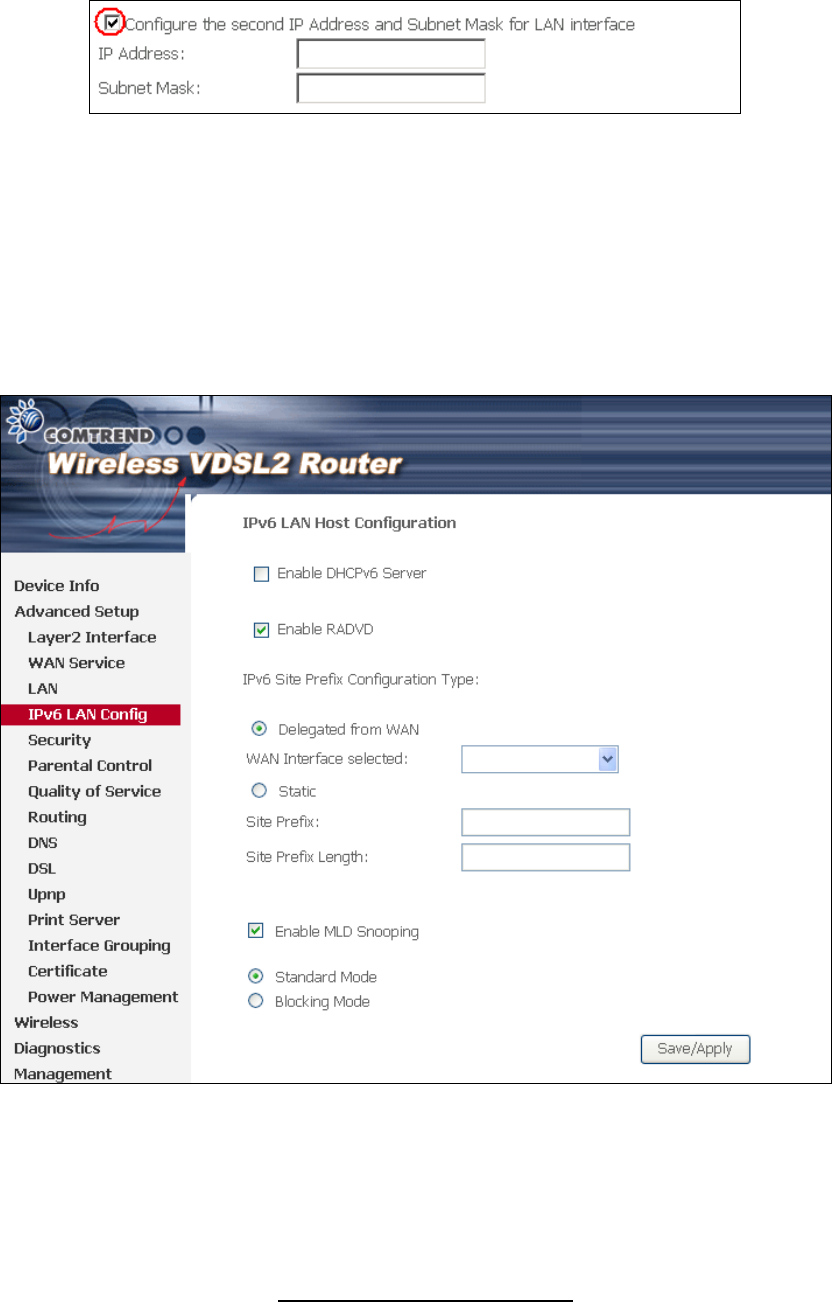
35
IP Address: Enter the secondary IP address for the LAN port.
Subnet Mask: Enter the secondary subnet mask for the LAN port.
5.4 IPv6 LAN Host
Configure the IPv6 LAN Host options (see below) and then click Save/Apply.
DHCPv6 Server: To enable DHCP for IPv6, select the Enable DHCPv6 server
checkbox . This setting enables the router to assign IP settings
to every IPv6-capable LAN device (IPv6 clients).
RADVD: Select the checkbox to enable the Router ADVertisement Daemon.
This provides information that IPv6 clients can use for autoconfiguration
according to the Neighbour Discovery for IPv6 protocol (RFC2461).
IPv6 Site Prefix
This setting can be delegated from a WAN Interface or assigned statically.
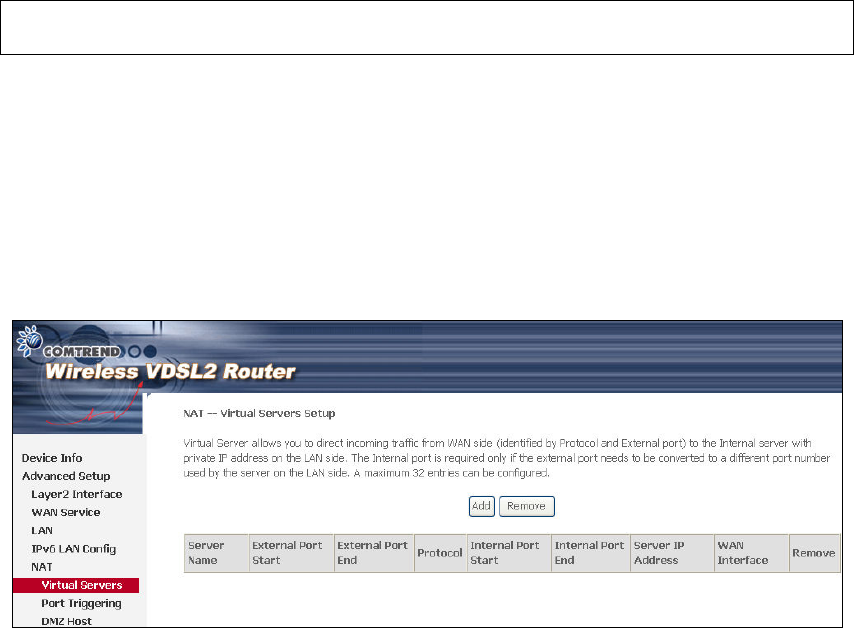
36
Enable MLD Snooping: Enable by ticking the checkbox .
Standard Mode: In standard mode, multicast traffic will flood to all
bridge ports when no client subscribes to a multicast
group – even if snooping is enabled.
Blocking Mode: In blocking mode, the multicast data traffic will be
blocked and not flood to all bridge ports when there are
no client subscriptions to any multicast group.
5.5 NAT
To display this option, NAT must be enabled in at least one PVC shown on the
Chapter 5 Advanced Setup - . NAT is not an available option in Bridge mode.
5.5.1 Virtual Servers
Virtual Servers allow you to direct incoming traffic from the WAN side (identified by
Protocol and External port) to the Internal server with private IP addresses on the
LAN side. The Internal port is required only if the external port needs to be
converted to a different port number used by the server on the LAN side.
A maximum of 32 entries can be configured.
To add a Virtual Server, click Add. The following will be displayed.
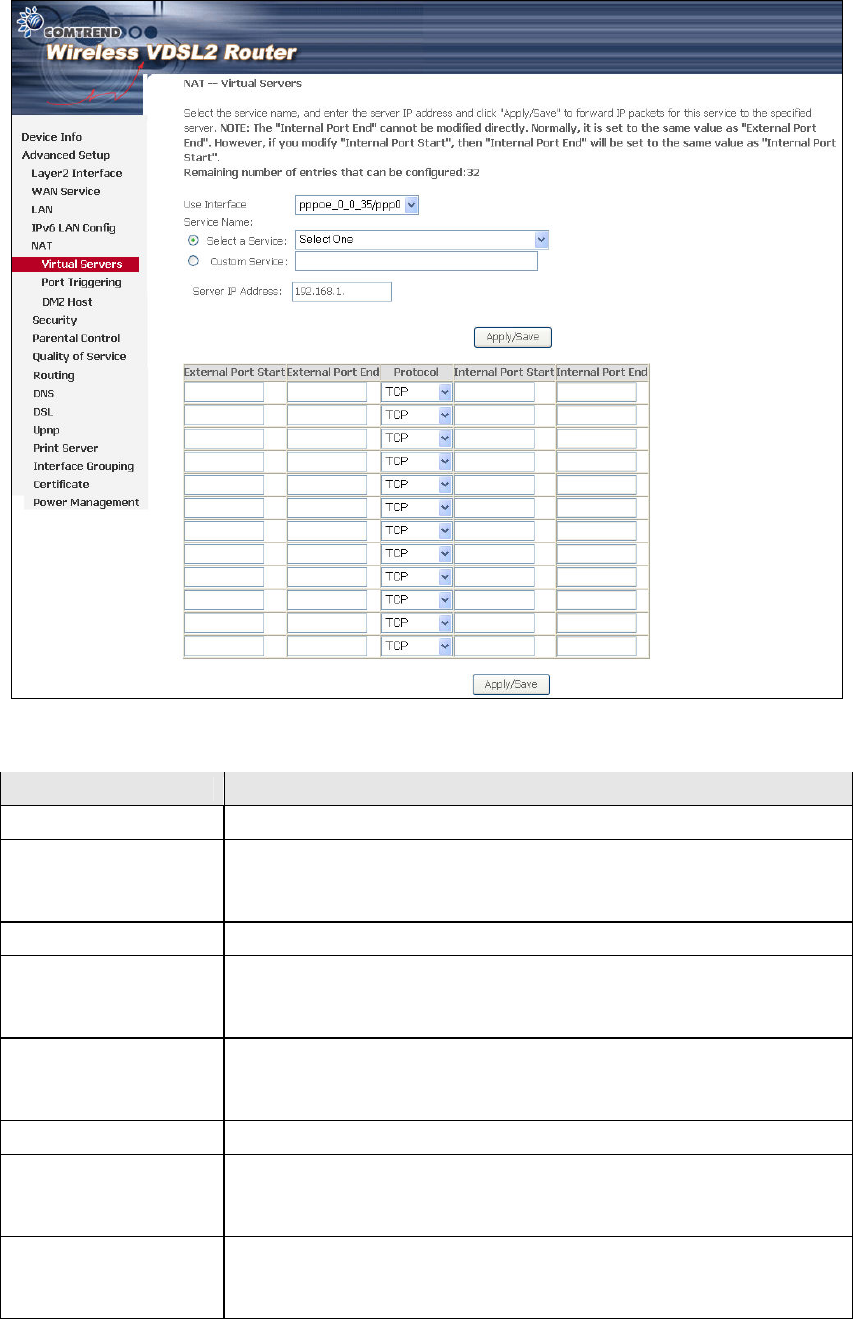
37
Consult the table below for field and header descriptions.
Field/Header Description
Use Interface Select a WAN interface from the drop-down box.
Select a Service
Or
Custom Service
User should select the service from the list.
Or
User can enter the name of their choice.
Server IP Address Enter the IP address for the server.
External Port Start Enter the starting external port number (when you select
Custom Server). When a service is selected, the port ranges
are automatically configured.
External Port End Enter the ending external port number (when you select
Custom Server). When a service is selected, the port ranges
are automatically configured.
Protocol TCP, TCP/UDP, or UDP.
Internal Port Start Enter the internal port starting number (when you select
Custom Server). When a service is selected the port ranges
are automatically configured
Internal Port End Enter the internal port ending number (when you select
Custom Server). When a service is selected, the port ranges
are automatically configured.
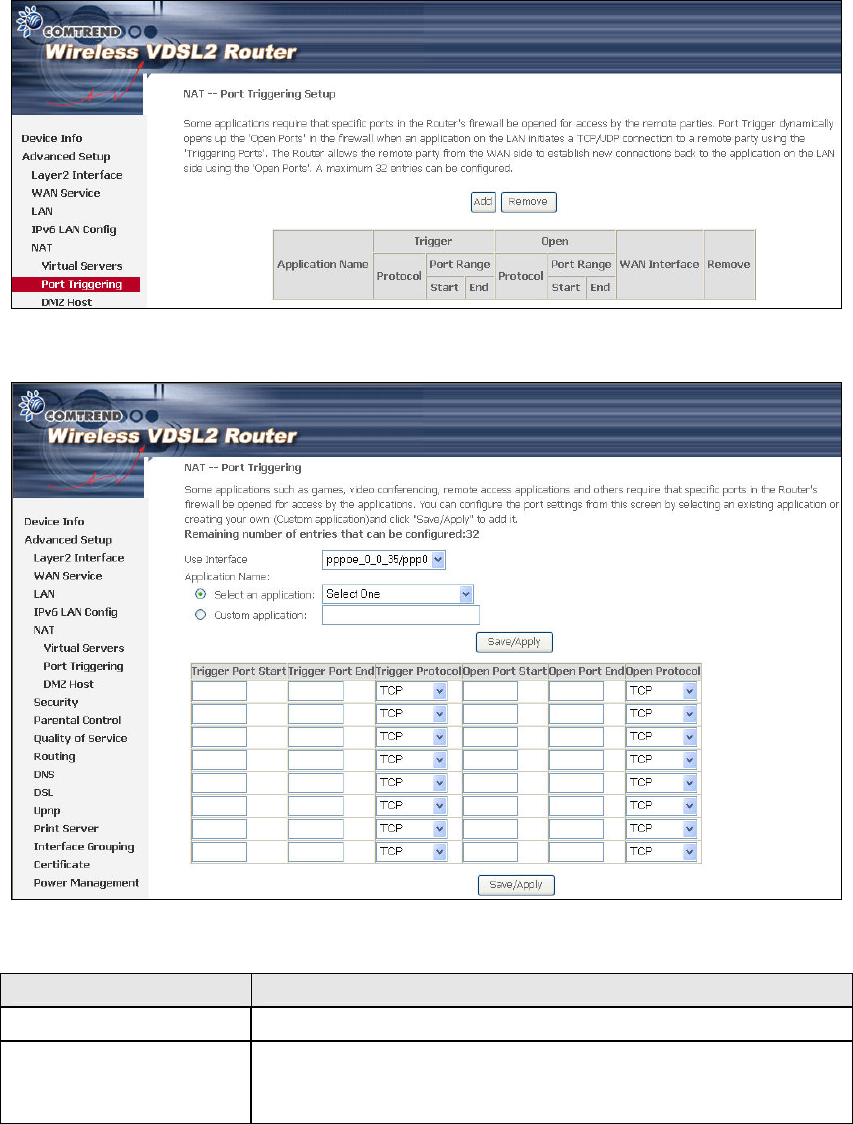
38
5.5.2 Port Triggering
Some applications require that specific ports in the firewall be opened for access by
the remote parties. Port Triggers dynamically 'Open Ports' in the firewall when an
application on the LAN initiates a TCP/UDP connection to a remote party using the
'Triggering Ports'. The Router allows the remote party from the WAN side to
establish new connections back to the application on the LAN side using the 'Open
Ports'. A maximum 32 entries can be configured.
To add a Trigger Port, click Add. The following will be displayed.
Consult the table below for field and header descriptions.
Field/Header Description
Use Interface Select a WAN interface from the drop-down box.
Select an Application
Or
Custom Application
User should select the application from the list.
Or
User can enter the name of their choice.
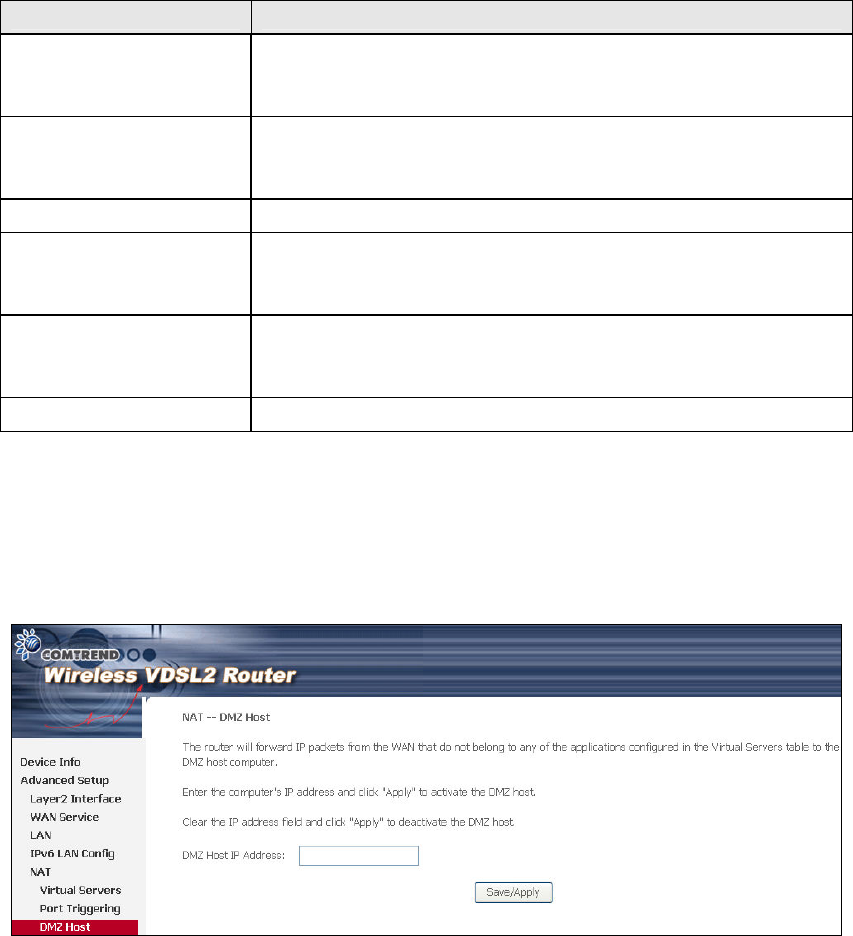
39
Field/Header Description
Trigger Port Start Enter the starting trigger port number (when you select
custom application). When an application is selected, the
port ranges are automatically configured.
Trigger Port End Enter the ending trigger port number (when you select
custom application). When an application is selected, the
port ranges are automatically configured.
Trigger Protocol TCP, TCP/UDP, or UDP.
Open Port Start Enter the starting open port number (when you select
custom application). When an application is selected, the
port ranges are automatically configured.
Open Port End Enter the ending open port number (when you select
custom application). When an application is selected, the
port ranges are automatically configured.
Open Protocol TCP, TCP/UDP, or UDP.
5.5.3 DMZ Host
The DSL router will forward IP packets from the WAN that do not belong to any of
the applications configured in the Virtual Servers table to the DMZ host computer.
To Activate the DMZ host, enter the DMZ host IP address and click Save/Apply.
To Deactivate the DMZ host, clear the IP address field and click Save/Apply.
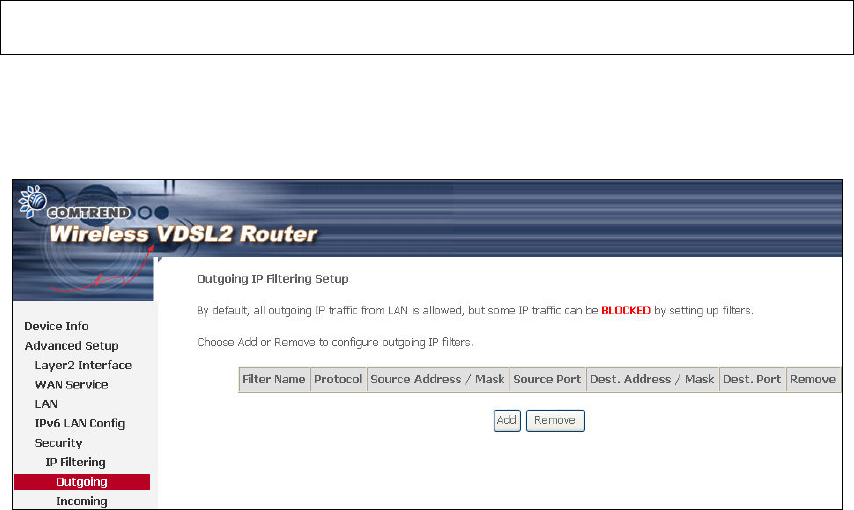
40
5.6 Security
To display this function, you must enable the firewall feature in WAN Setup.
For detailed descriptions, with examples, please consult Appendix A - Firewall.
5.6.1 IP Filtering
This screen sets filter rules that limit IP traffic (Outgoing/Incoming). Multiple filter
rules can be set and each applies at least one limiting condition. For individual IP
packets to pass the filter all conditions must be fulfilled.
NOTE: This function is not available when in bridge mode. Instead, 5.6.2 MAC
Filtering (pg. 422) performs a similar function.
OUTGOING IP FILTER
By default, all outgoing IP traffic is allowed, but IP traffic can be blocked with filters.
To add a filter (to block some outgoing IP traffic), click the Add button.
On the following screen, enter your filter criteria and then click Apply/Save.
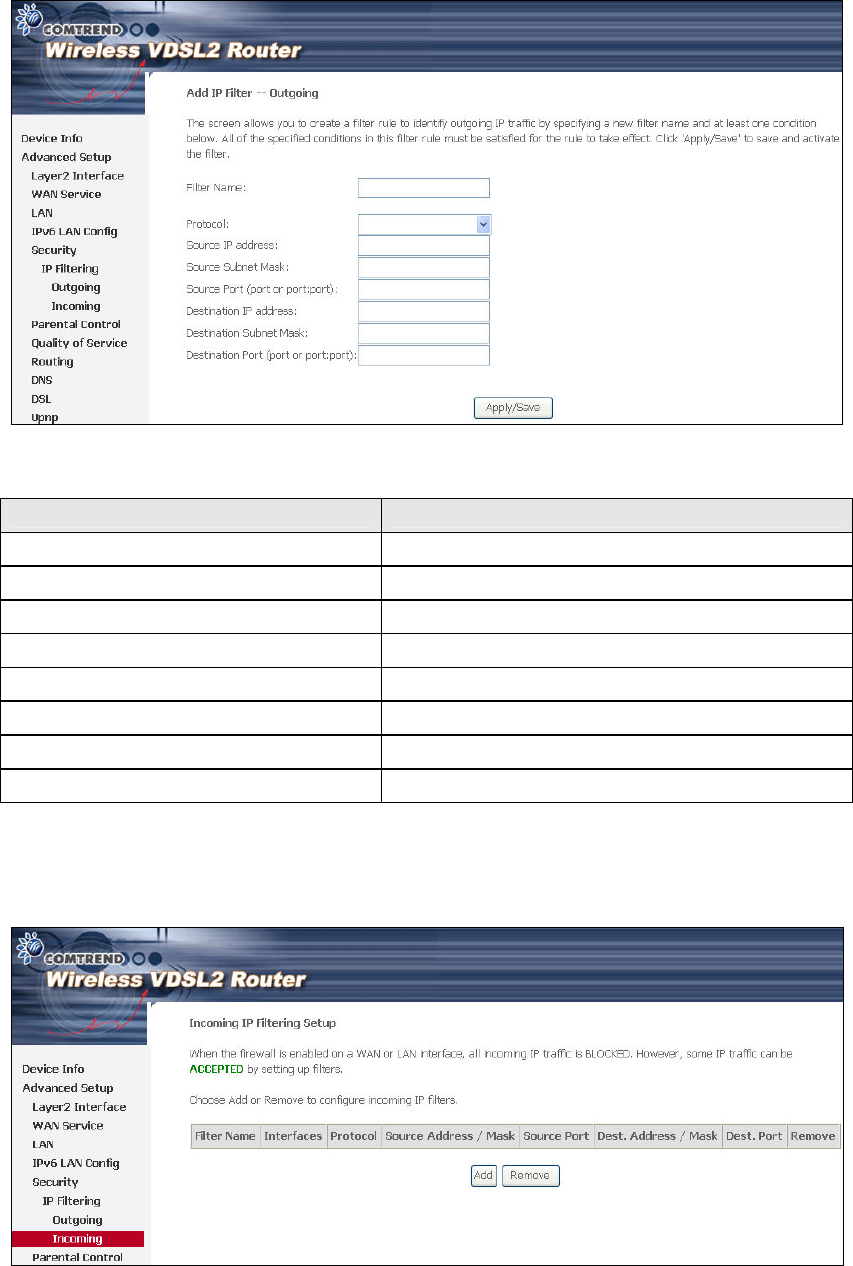
41
Consult the table below for field descriptions.
Field Description
Filter Name The filter rule label
Protocol TCP, TCP/UDP, UDP, or ICMP.
Source IP address Enter source IP address.
Source Subnet Mask Enter source subnet mask.
Source Port (port or port:port) Enter source port number or range.
Destination IP address Enter destination IP address.
Destination Subnet Mask Enter destination subnet mask.
Destination Port (port or port:port)
Enter destination port number or range.
INCOMING IP FILTER
By default, all incoming IP traffic is blocked, but IP traffic can be allowed with filters.
To add a filter (to allow incoming IP traffic), click the Add button.
On the following screen, enter your filter criteria and then click Apply/Save.
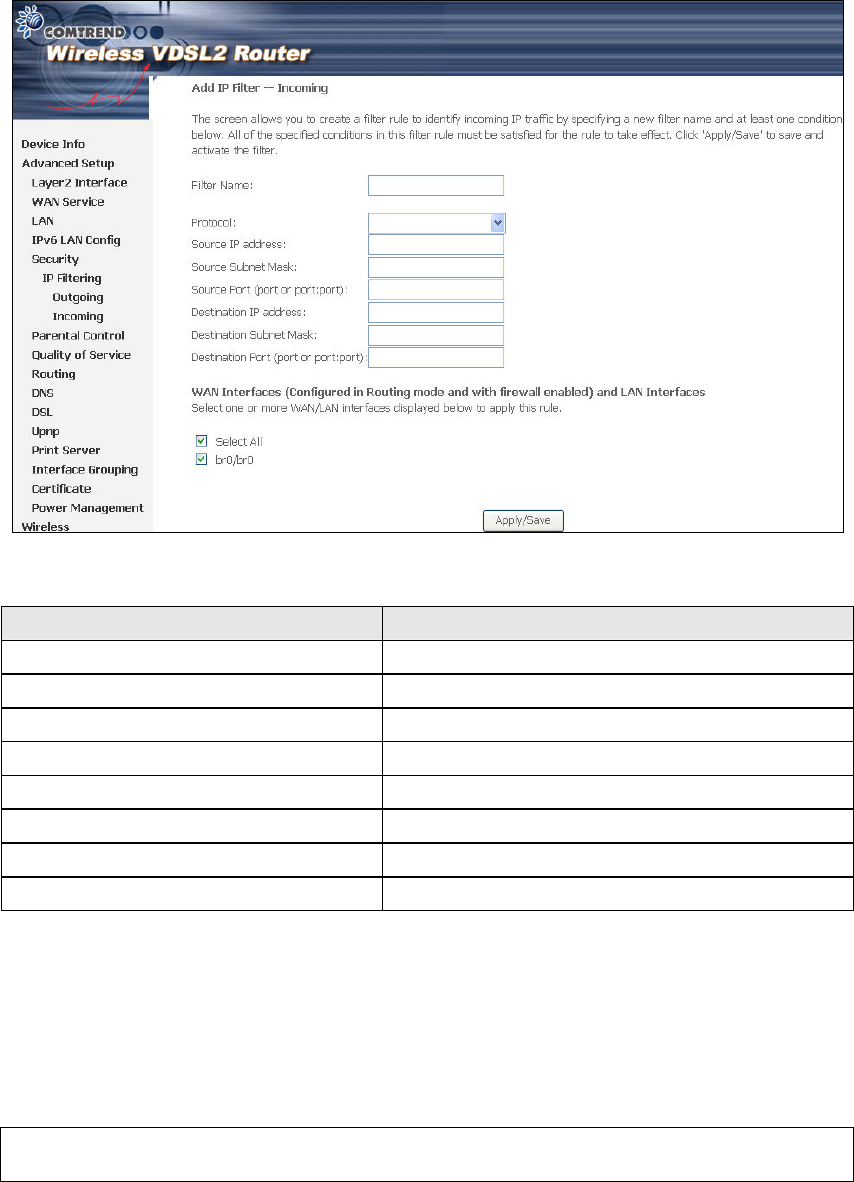
42
Consult the table below for field descriptions.
Field Description
Filter Name The filter rule label
Protocol TCP, TCP/UDP, UDP, or ICMP.
Source IP address Enter source IP address.
Source Subnet Mask Enter source subnet mask.
Source Port (port or port:port) Enter source port number or range.
Destination IP address Enter destination IP address.
Destination Subnet Mask Enter destination subnet mask.
Destination Port (port or port:port)
Enter destination port number or range.
At the bottom of this screen, select the WAN and LAN Interfaces to which the filter
rule will apply. You may select all or just a subset. WAN interfaces in bridge mode or
without firewall enabled are not available.
5.6.2 MAC Filtering
NOTE: This option is only available in bridge mode. Other modes use 5.6.1
IP Filtering (pg. 40) to perform a similar function.
Each network device has a unique 48-bit MAC address. This can be used to filter
(block or forward) packets based on the originating device. MAC filtering policy and
rules for the CT-5374 can be set according to the following procedure.
The MAC Filtering Global Policy is defined as follows. FORWARDED means that all
MAC layer frames will be FORWARDED except those matching the MAC filter rules.
BLOCKED means that all MAC layer frames will be BLOCKED except those
matching the MAC filter rules. The default MAC Filtering Global policy is
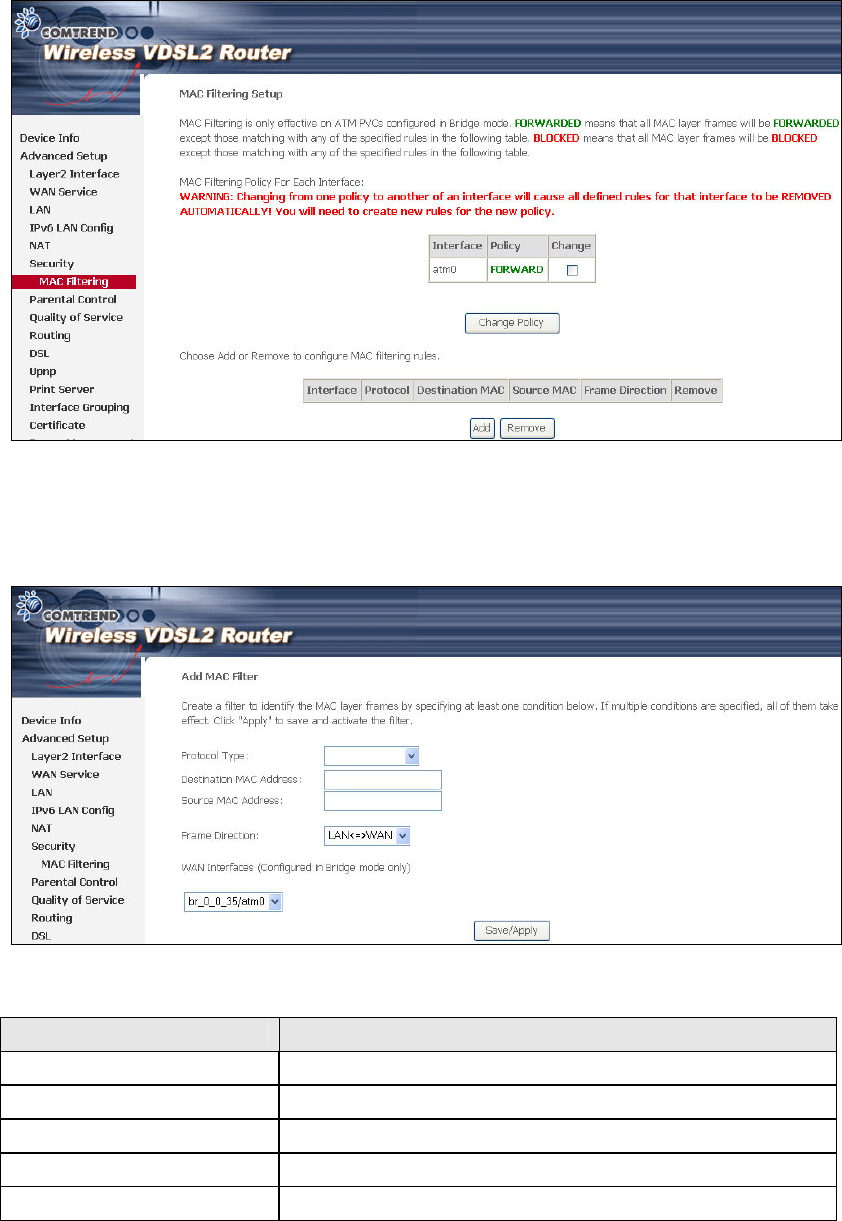
43
FORWARDED. It can be changed by clicking the Change Policy button.
Choose Add or Remove to configure MAC filtering rules. The following screen will
appear when you click Add. Create a filter to identify the MAC layer frames by
specifying at least one condition below. If multiple conditions are specified, all of
them must be met. Click Save/Apply to save and activate the filter rule.
Consult the table below for detailed field descriptions.
Field Description
Protocol Type PPPoE, IPv4, IPv6, AppleTalk, IPX, NetBEUI, IGMP
Destination MAC Address
Defines the destination MAC address
Source MAC Address Defines the source MAC address
Frame Direction Select the incoming/outgoing packet interface
WAN Interfaces Applies the filter to the selected bridge interface.
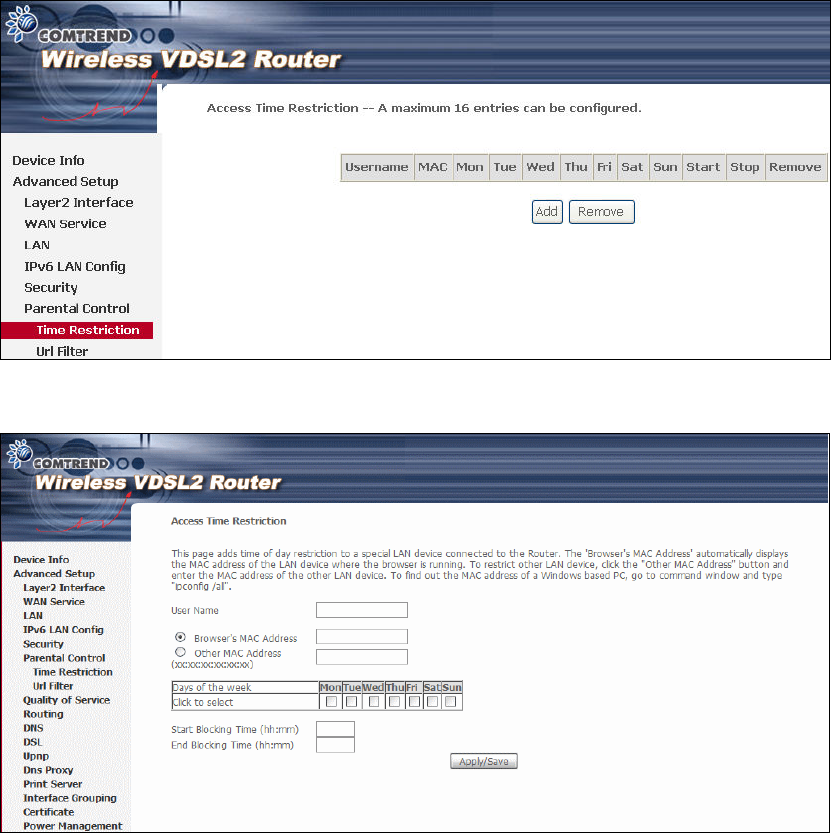
44
5.7 Parental Control
This selection provides WAN access control functionality.
5.7.1 Time Restriction
This feature restricts access from a LAN device to an outside network through the
device on selected days at certain times. Make sure to activate the Internet Time
server synchronization as described in 8.5 Internet Time, so that the scheduled
times match your local time.
Click Add to display the following screen.
See below for field descriptions. Click Apply/Save to add a time restriction.
User Name: A user-defined label for this restriction.
Browser's MAC Address: MAC address of the PC running the browser.
Other MAC Address: MAC address of another LAN device.
Days of the Week: The days the restrictions apply.
Start Blocking Time: The time the restrictions start.
End Blocking Time: The time the restrictions end.
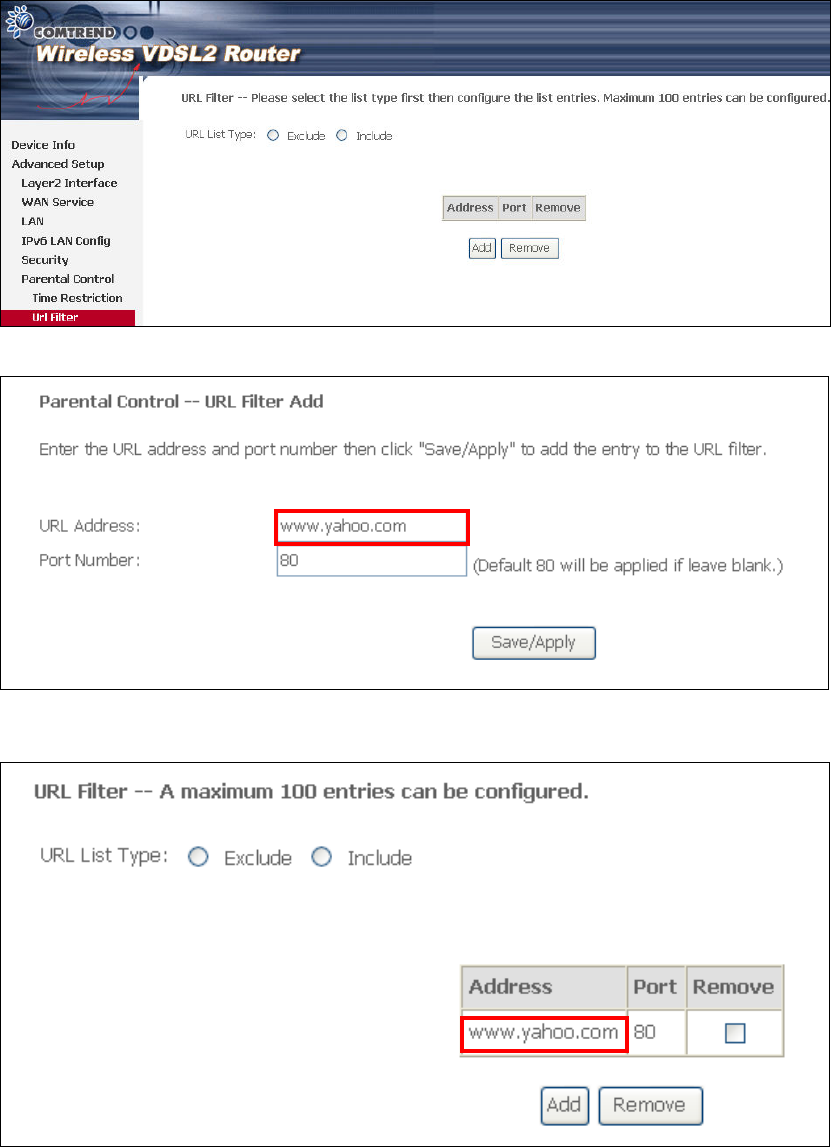
45
5.7.2 URL Filter
This screen allows for the creation of a filter rule for access rights to websites based
on their URL address and port number.
Click Add to display the following screen.
Enter the URL address and port number then click Save/Apply to add the entry to
the URL filter. URL Addresses begin with “www”, as shown in this example.
A maximum of 100 entries can be added to the URL Filter list.
Tick the Exclude radio button to deny access to the websites listed.
Tick the Include radio button to restrict access to only those listed websites.
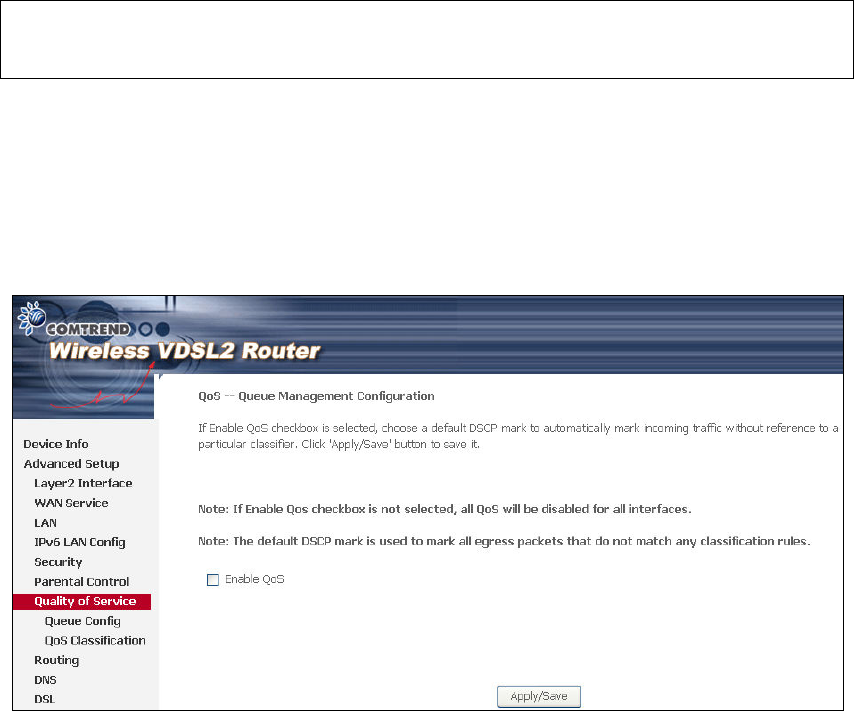
46
5.8 Quality of Service (QoS)
NOTE: QoS must be enabled in at least one PVC to display this option.
(see Appendix G - Connection Setup for detailed PVC setup instructions).
5.8.1 Queue Management Configuration
To Enable QoS tick the checkbox and select a Default DSCP Mark.
Click Apply/Save to activate QoS.
QoS and DSCP Mark are defined as follows:
Quality of Service (QoS): This provides different priority to different users or data
flows, or guarantees a certain level of performance to a data flow in accordance with
requests from Queue Prioritization.
Default Differentiated Services Code Point (DSCP) Mark: This specifies the
per hop behavior for a given flow of packets in the Internet Protocol (IP) header that
do not match any other QoS rule.
5.8.2 Queue Configuration
This function follows the Differentiated Services rule of IP QoS. You can create a new
Queue entry by clicking the Add button. Enable and assign an interface and
precedence on the next screen. Click Save/Reboot on this screen to activate it.
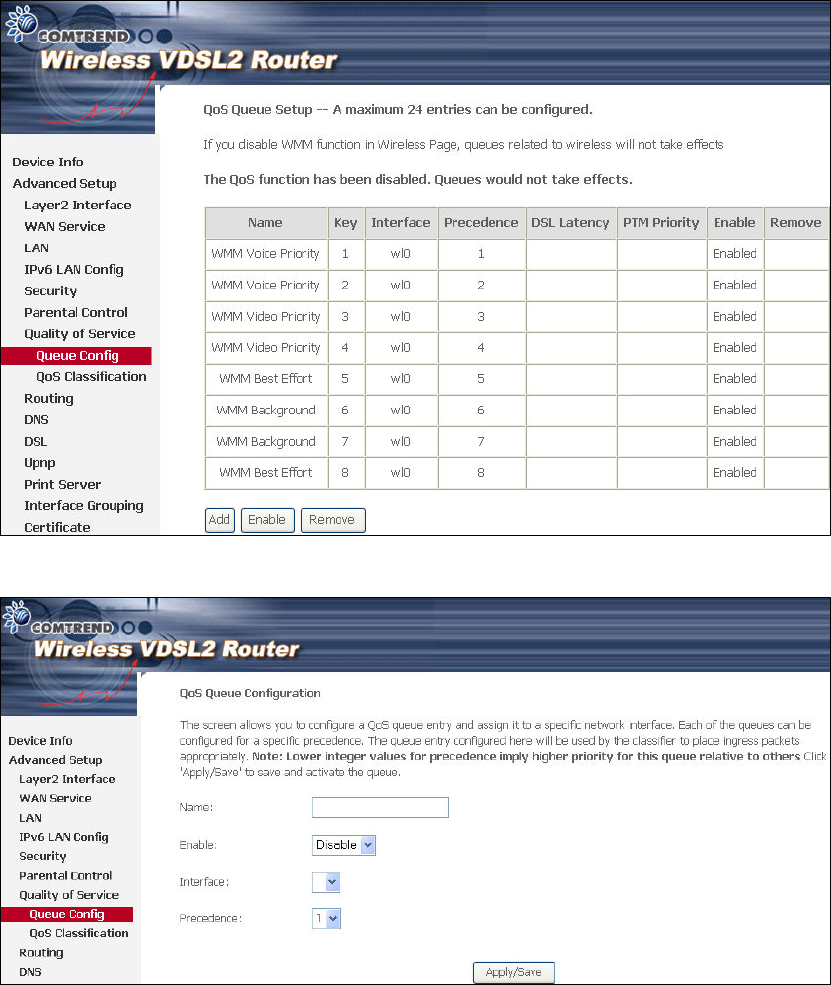
47
Click Enable to activate the QoS Queue. Click Add to display the following screen.
Name: Identifier for this Queue entry.
Enable: Enable/Disable the Queue entry.
Interface: Assign the entry to a specific network interface (QoS enabled).
Precedence: Configure precedence for the Queue entry. Lower integer values for
precedence imply higher priority for this entry relative to others.
5.8.3 QoS Classification
The network traffic classes are listed in the following table.
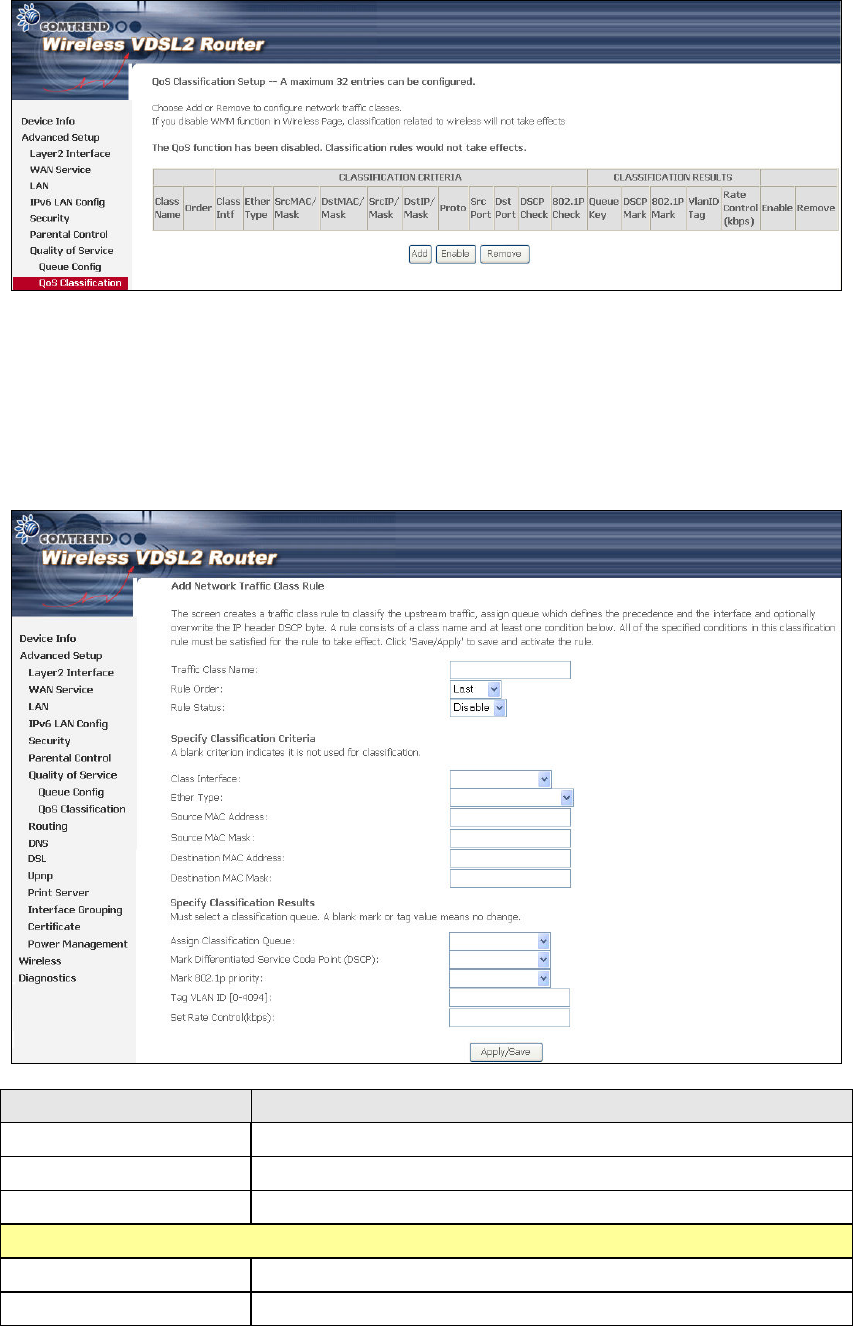
48
Click Add to configure a network traffic class rule and Enable to activate it. To
delete an entry from the list, click Remove.
This screen creates a traffic class rule to classify the upstream traffic, assign
queuing priority and optionally overwrite the IP header DSCP byte. A rule consists of
a class name and at least one logical condition. All the conditions specified in the
rule must be satisfied for it to take effect.
Field Description
Traffic Class Name Enter a name for the traffic class.
Rule Order Last is the only option.
Rule Status Disable or enable the rule.
Classification Criteria
Class Interface Select an interface (i.e. Local, eth0-4, wl0)
Ether Type Set the Ethernet type (e.g. IP, ARP, IPv6).

49
Field Description
Source MAC Address A packet belongs to SET-1, if a binary-AND of its source
MAC address with the Source MAC Mask is equal to the
binary-AND of the Source MAC Mask and this field.
Source MAC Mask This is the mask used to decide how many bits are checked
in Source MAC Address.
Destination MAC
Address
A packet belongs to SET-1 then the result that the
Destination MAC Address of its header binary-AND to the
Destination MAC Mask must equal to the result that this
field binary-AND to the Destination MAC Mask.
Destination MAC Mask
This is the mask used to decide how many bits are checked
in Destination MAC Address.
Classification Results
Assign Classification
Queue
The queue configurations are presented in this format:
“Interfacename&Prece P&Queue Q” where P and Q are the
Precedence and Queue Key values for the corresponding
Interface as listed on the Queue Config screen.
Mark Differentiated
Service Code Point
The selected Code Point gives the corresponding priority to
packets that satisfy the rule.
Mark 802.1p Priority Select between 0-7. Lower values have higher priority.
Tag VLAN ID Enter a 802.1Q VLAN ID tag [2-4094]
Set Rate Control The data transmission rate limit in kbps.
5.9 Routing
This following routing functions are accessed from this menu:
Default Gateway, Static Route, Policy Routing, RIP and IPv6 Static Route.
NOTE: In bridge mode, the RIP menu option is hidden while the other menu
options are shown but ineffective.